Uganda is a paradise for bird-lovers, with more than 1040 species of birds – the highest bird diversity in all of Africa. This incredibly biodiverse country offers a variety of habitats and climates, making it an ideal home for a wide range of bird species.
From the lowland rainforests in the south to the savannas of the north, Uganda is a bird-watcher’s paradise. From the common grey parrot to the colorful African Pitta, Uganda is home to a diverse and vibrant avian community.
Whether you are a beginner or an experienced bird-watcher, Uganda is sure to provide an unforgettable experience.
1. Grey Crowned Crane
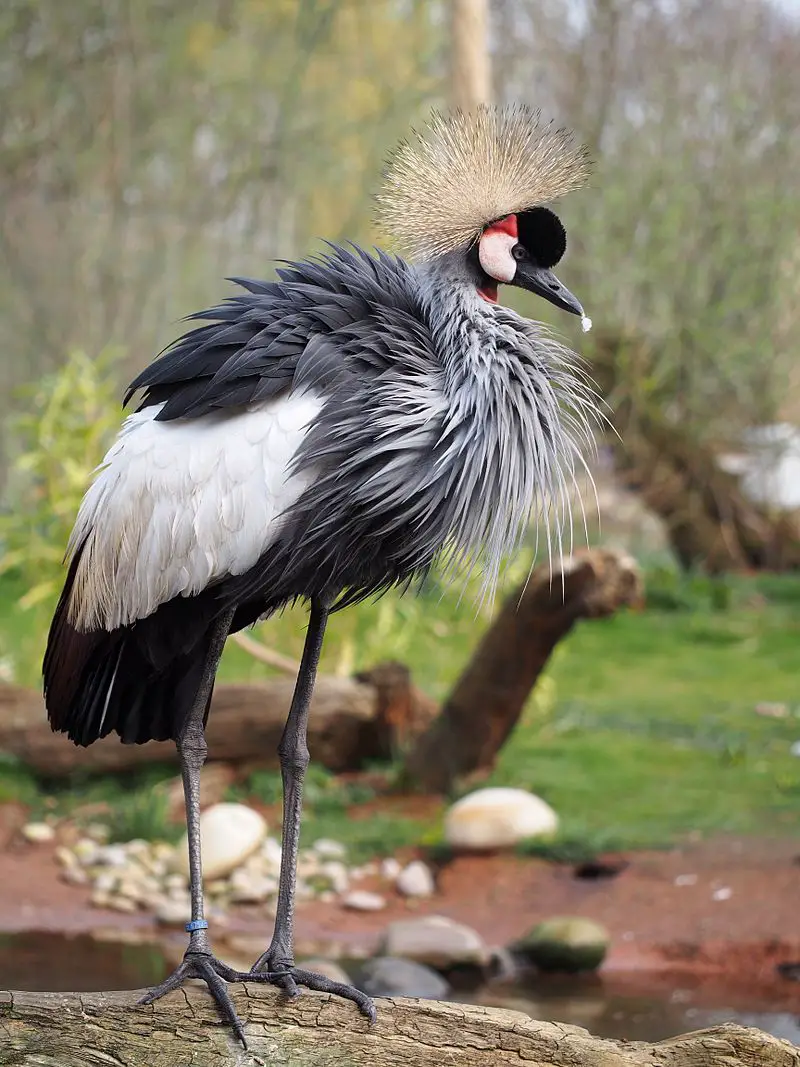
The Grey Crowned Crane is a beautiful bird native to eastern and southern Africa. It belongs to the crane family, Gruidae, and its stunning plumage consists of grey feathers topped with golden crowns on their heads.
This species has become Uganda’s national bird due to its gracefulness in flight as well as for being an important part of local cultures across the continent.
The Grey Crowned Crane stands out from other birds not only because of its colorful appearance but also because it performs elaborate mating dances involving leaps, bows, throwing their head back or flapping wings while calling loudly – all in an effort to attract a mate.
In addition to these displays they are highly social animals that form strong bonds with one another and can live up 20 years if given proper care.Scientific classification:
| Kingdom | Animalia |
| Phylum | Chordata |
| Class | Aves |
| Order | Gruiformes |
| Family | Gruidae |
| Genus | Balearica |
| Species | B. regulorum |
2. Standard-Winged Nightjar
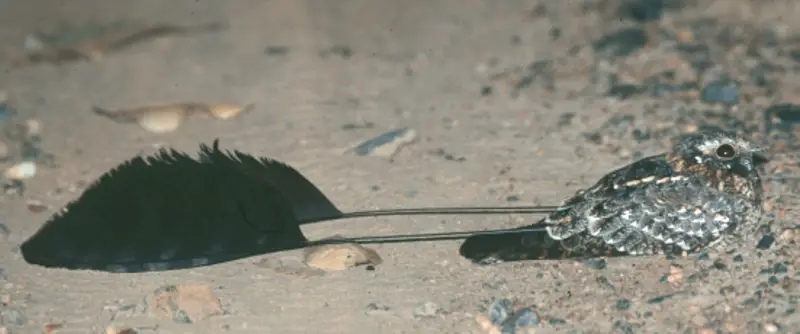
The Standard-winged nightjar is a nocturnal bird belonging to the nightjar family. It can be found in dry savannah habitats and some scrub across Africa, from Senegal east to Ethiopia.
During breeding season, adult males have an unusual wing ornament consisting of a broad central flight feather on each wing that elongates up to 38 centimetres (15 inches).
They also boast distinctive black throats with white spots which contrast against their brown and grey plumage.
The wings’ undersides are marked by two whitish bars while white patches at the base of its tail add further detail when in flight. In addition, they possess large eyes adapted for hunting food such as insects during twilight hours whilst keeping still and silent like other members of this secretive species.Scientific classification:
| Kingdom | Animalia |
| Phylum | Chordata |
| Class | Aves |
| Order | Caprimulgiformes |
| Family | Caprimulgidae |
| Genus | Caprimulgus |
| Species | C. longipennis |
3. Green-Breasted Pitta
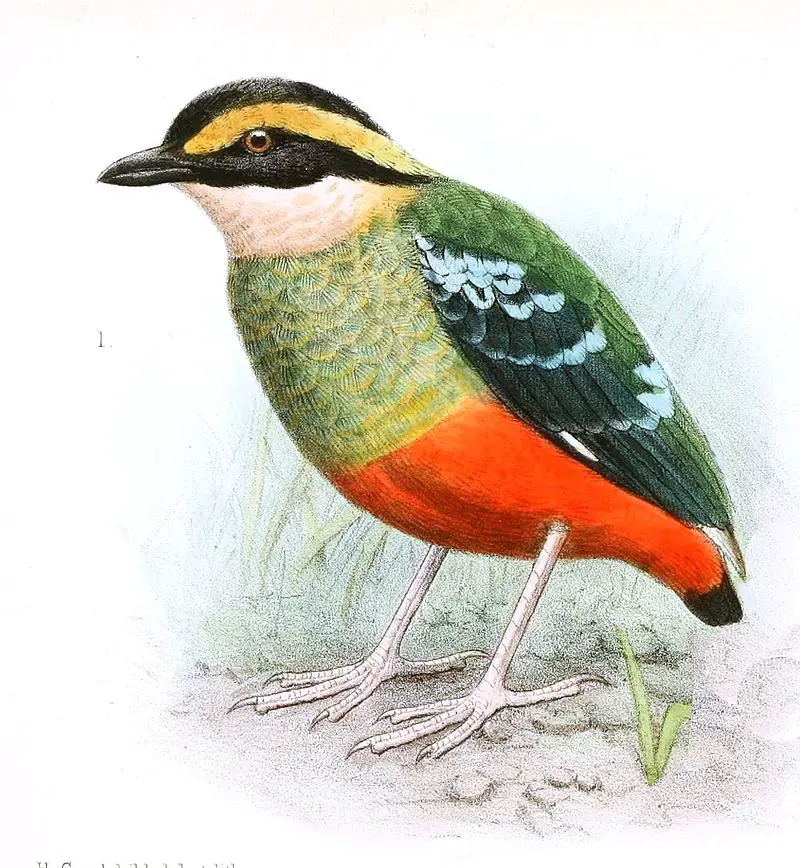
The Green-breasted pitta is an amazing bird species belonging to the Pittidae family that can be found in deep forest of tropical climates. It has a stunning plumage, with its breast being green and its throat bordered by a black line.
Immature birds have darker and duller feathers, along with a brownish olive coloured breast. This type of pitta is one out two existing species in Africa and it can be spotted in Cameroon as well.
These beautiful creatures are small sized but very lively; they feed on insects like ants, termites or mayflies which makes them essential for maintaining the balance of their environment’s ecosystem.Scientific classification:
| Kingdom | Animalia |
| Phylum | Chordata |
| Class | Aves |
| Order | Passeriformes |
| Family | Pittidae |
| Genus | Pitta |
| Species | P. reichenowi |
4. Doherty’s Bushshrike
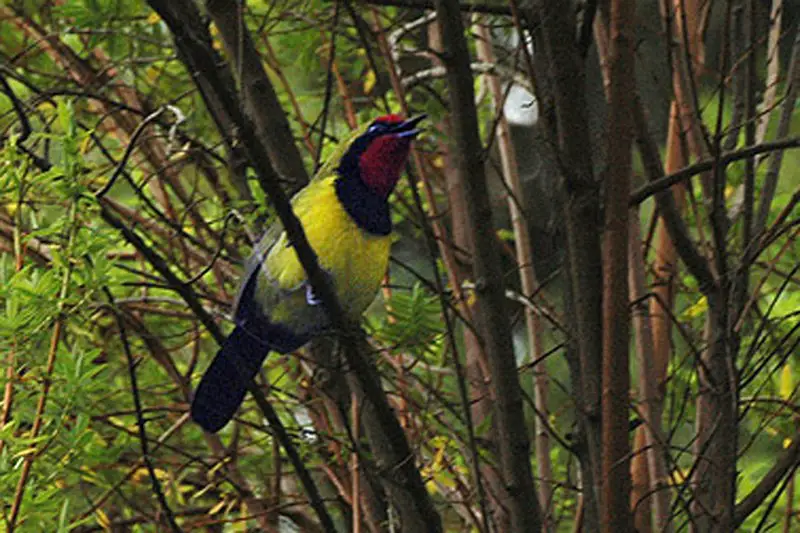
Doherty’s bushshrike is a beautiful bird found in north-central Africa. It has an unmistakable appearance due to its bright green body and vivid red forehead, throat and breast.
The species was named after American collector William Doherty who first discovered it in the late 19th century. Its skulking behavior makes this bird tricky to spot but when you do catch sight of one, its beauty will make it hard to forget.
This medium sized bush shrike prefers forests as their habitats and enjoys foraging for insects on tree trunks or branches. While not commonly seen, those lucky enough can enjoy watching these majestic creatures flitting through African woodlands.Scientific classification:
| Kingdom | Animalia |
| Phylum | Chordata |
| Class | Aves |
| Order | Passeriformes |
| Family | Malaconotidae |
| Genus | Telophorus |
| Species | T. dohertyi |
5. Marabou Stork
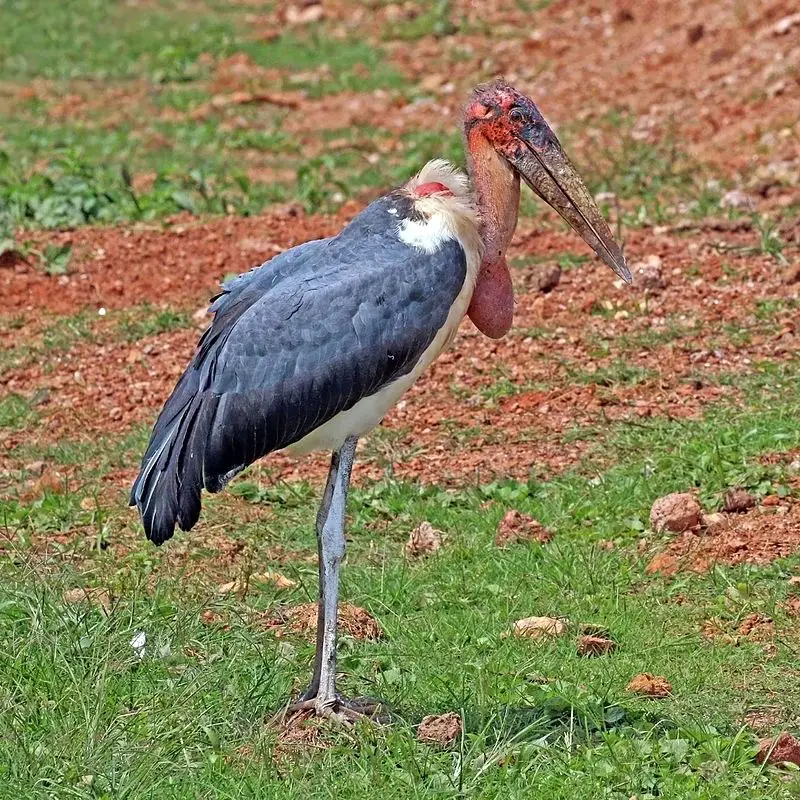
The marabou stork is a large wading bird native to sub-Saharan Africa. It has an unmistakable appearance, with cloak-like wings and back, skinny white legs and sometimes a large mass of “hair”.
They reside in both wet and arid habitats near human habitation, often found at landfill sites.
This species has earned the nickname ‘undertaker bird’ due to its unique shape viewed from behind.
Despite living alongside humans they remain elusive birds who rarely interact with us but can still be seen gliding on thermals or standing majestically by lakesides.
The marabou stork is truly an impressive sight that will stay in your memory forever.Scientific classification:
| Kingdom | Animalia |
| Phylum | Chordata |
| Class | Aves |
| Order | Ciconiiformes |
| Family | Ciconiidae |
| Genus | Leptoptilos |
| Species | L. crumenifer |
6. Bar-Tailed Trogon
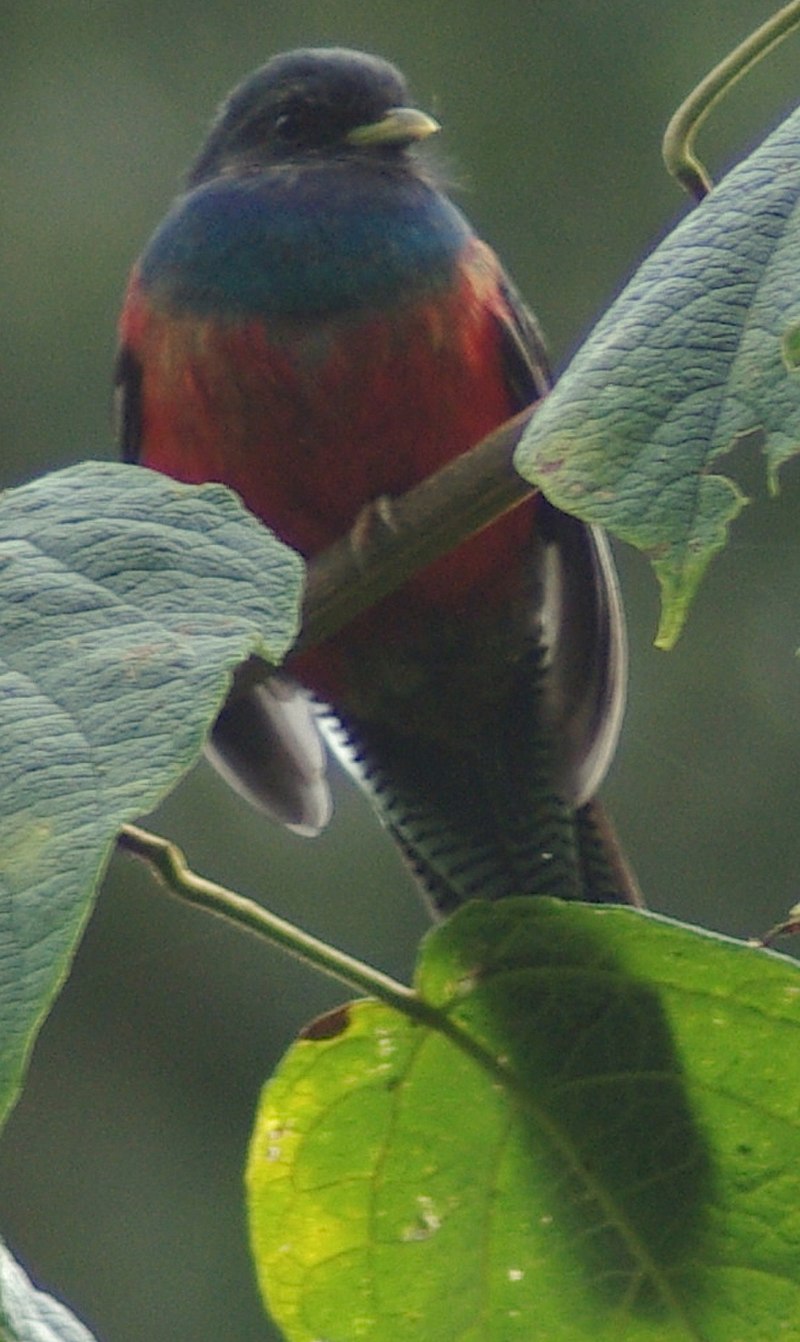
The Bar-tailed Trogon is a beautiful bird native to central Africa. It has yellow bill and feet, along with a long and broad tail that is narrowly barred with black and white on the underside.
The male’s head is blue-black in colour while the female’s head is more brownish grey. Its diet consists mainly of insects and fruits, but occasionally it will take small lizards or frogs as well.
This colourful bird typically grows up to 28 centimetres (11 in) in length, making it an impressive sight when seen out in nature.Scientific classification:
| Kingdom | Animalia |
| Phylum | Chordata |
| Class | Aves |
| Order | Trogoniformes |
| Family | Trogonidae |
| Genus | Apaloderma |
| Species | A. vittatum |
Also Featured In: Big Birds that Live in Uganda, Large Birds of Uganda
7. Shelley’s Crimsonwing
Shelley’s crimsonwing is a striking species of estrildid finch. It is found in Burundi, eastern Democratic Republic of the Congo, Rwanda and western Uganda where it lives amongst low vegetation such as shrubs and grasses.
This beautiful bird has bright red-orange wings with yellowish underparts which make it stand out from its habitat.
Unfortunately Shelley’s Crimsonwings are facing significant population decline due to uncontrolled deforestation across their range which has resulted in an estimated 2,500–9,999 birds remaining today.
Conservation efforts need to be put into place urgently if we wish for this unique species to survive for future generations to admire.Scientific classification:
| Kingdom | Animalia |
| Phylum | Chordata |
| Class | Aves |
| Order | Passeriformes |
| Family | Estrildidae |
| Genus | Cryptospiza |
| Species | C. shelleyi |
Also Featured In: Endemic Birds of Uganda that You Need to Know,
8. Black-Breasted Barbet
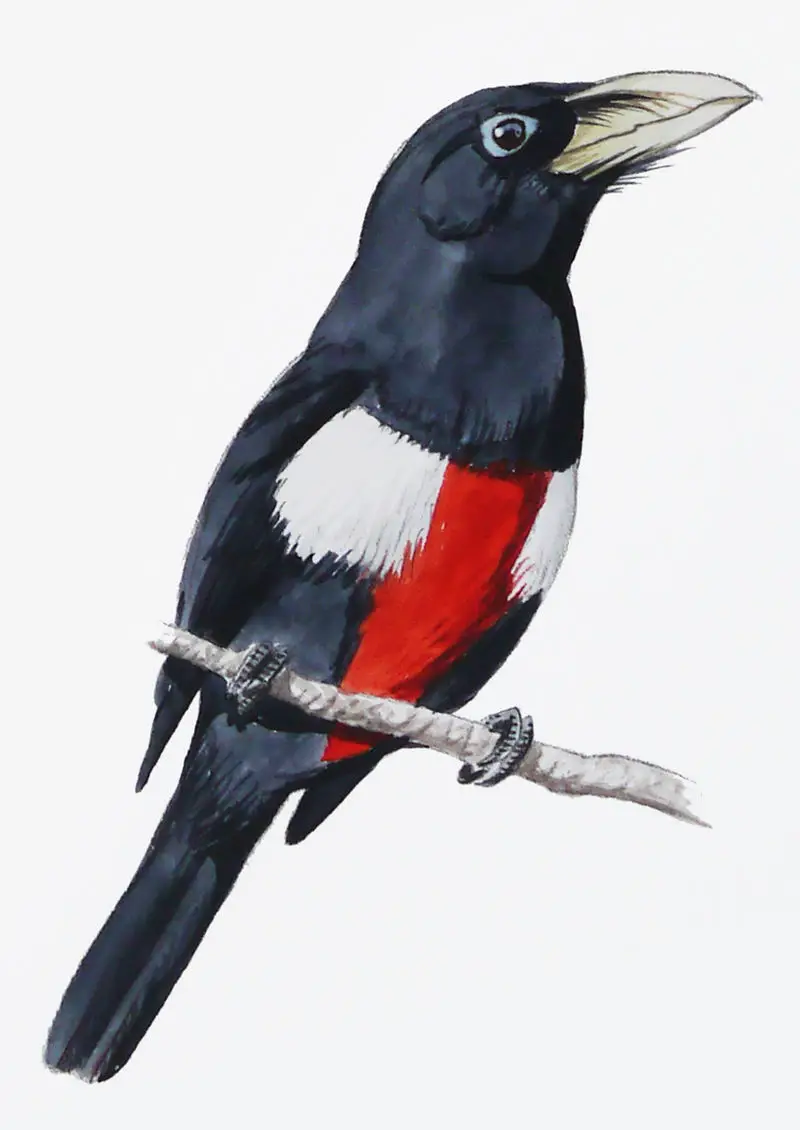
The Black-breasted Barbet is a species of bird found in Central African Republic, Chad, Sudan, South Sudan and the extreme northeast of Democratic Republic of Congo.
It inhabits woodlands at altitudes ranging from 200m to 2134m. This unique looking bird has black feathers on its breast while the rest of its body is coloured yellowish-green or grey with some streaks.
Its bright eyes are surrounded by white markings which makes them stand out even more against their dark head plumage. They feed mainly on fruit but have been known to also eat insects too.
These birds make loud calls during mating season as they try to attract potential mates – making it easier for us humans to spot this beautiful creature among the trees.Scientific classification:
| Kingdom | Animalia |
| Phylum | Chordata |
| Class | Aves |
| Order | Piciformes |
| Family | Lybiidae |
| Genus | Lybius |
| Species | L. rolleti |
9. Saddle-Billed Stork
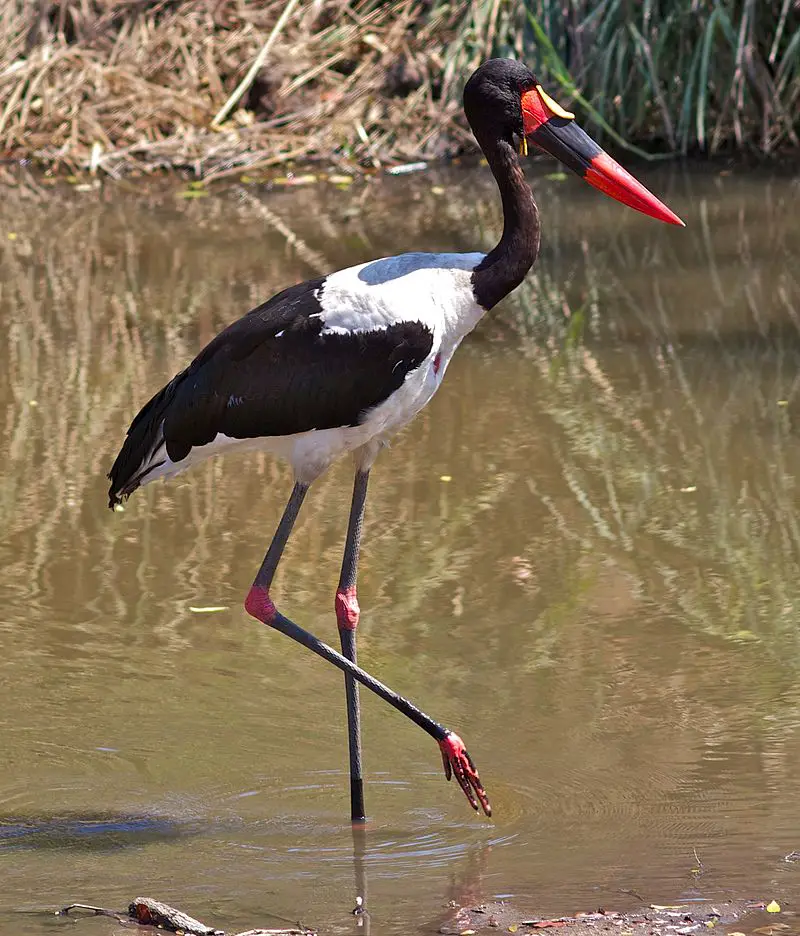
The Saddle-billed Stork is a large wading bird from the stork family, Ciconiidae. It can be found in sub-Saharan Africa and some parts of western Africa.
This majestic bird stands out with its striking features – it has an impressive bill that looks like a saddle and bright red legs which contrast against its white plumage on top.
The Saddle-billed Stork’s diet consists mostly of fish, frogs, aquatic invertebrates as well as small reptiles or mammals they come across while scavenging for food in wetland areas.
Sadly, this species is considered endangered in South Africa due to habitat loss and degradation caused by human activities such as drainage projects and agricultural expansion.
We must take action to protect these beautiful creatures before their numbers decrease further.Scientific classification:
| Kingdom | Animalia |
| Phylum | Chordata |
| Class | Aves |
| Order | Ciconiiformes |
| Family | Ciconiidae |
| Genus | Ephippiorhynchus |
| Species | E. senegalensis |
10. Black Bee-Eater
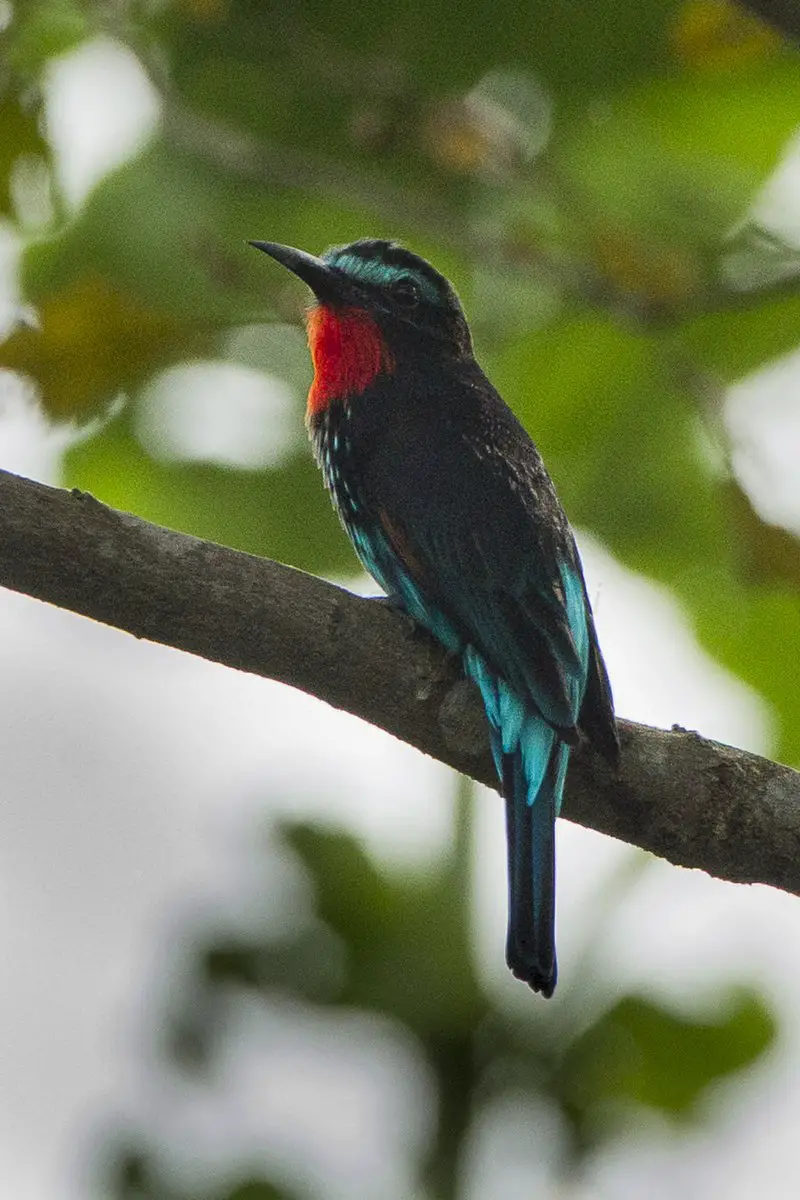
The Black bee-eater is an impressive bird that loves to live in the African tropical rainforest. It has a length of around 20 cm and its predominantly black body features some striking colors such as scarlet chin, throat, blue eyebrow, belly and undertail-coverts.
This beautiful creature also enjoys frequenting secondary woodland at the edges of its natural habitat. Its diet mainly consists of bees which it hunts by flying close to them or perching on branches waiting for prey to pass nearby.
During breeding season they construct their nests inside sandy banks where they lay 2–3 eggs each year while both parents take turns incubating them until they hatch and care for their young ones afterwards.
Although not endangered yet this species still needs our protection so we can all enjoy these incredible birds.Scientific classification:
| Kingdom | Animalia |
| Phylum | Chordata |
| Class | Aves |
| Order | Coraciiformes |
| Family | Meropidae |
| Genus | Merops |
| Species | M. gularis |
11. Yellow-Billed Oxpecker
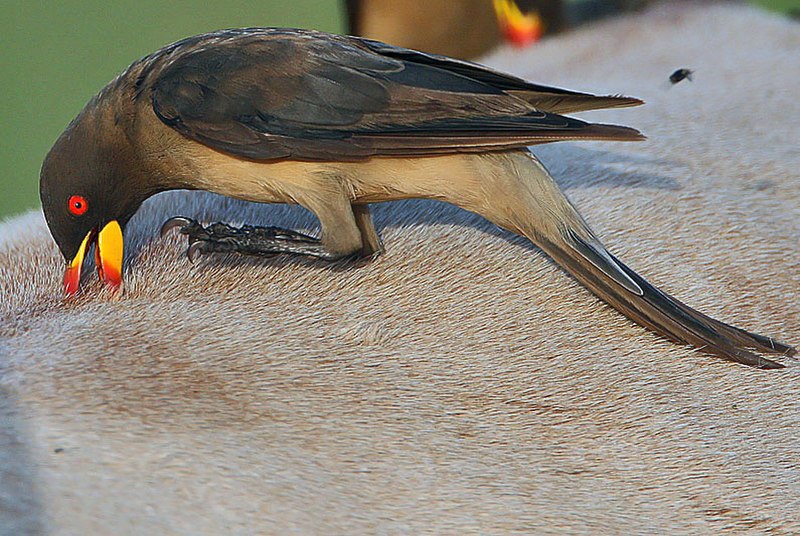
The Yellow-billed Oxpecker is a passerine bird native to the savannahs of Sub-Saharan Africa. It was previously placed in the starling and myna family, Sturnidae.
These birds are characterized by their bright yellow bills, which give them their name.
They feed mainly on insects found on large mammals such as wildebeests and zebras, but also consume fruits from nearby trees or shrubs when available.
The species tends to dominate over its smaller relative -the Red-billed oxpecker – whenever they share feeding grounds together; although it is least common in eastern parts of its range where they overlap with each other’s territories.
All in all, this beautiful avian creature makes for an interesting sight while exploring the African Savannah.Scientific classification:
| Kingdom | Animalia |
| Phylum | Chordata |
| Class | Aves |
| Order | Passeriformes |
| Family | Buphagidae |
| Genus | Buphagus |
| Species | B. africanus |
Also Featured In: Savanna Birds You Need to See, East African Birds
12. African Jacana
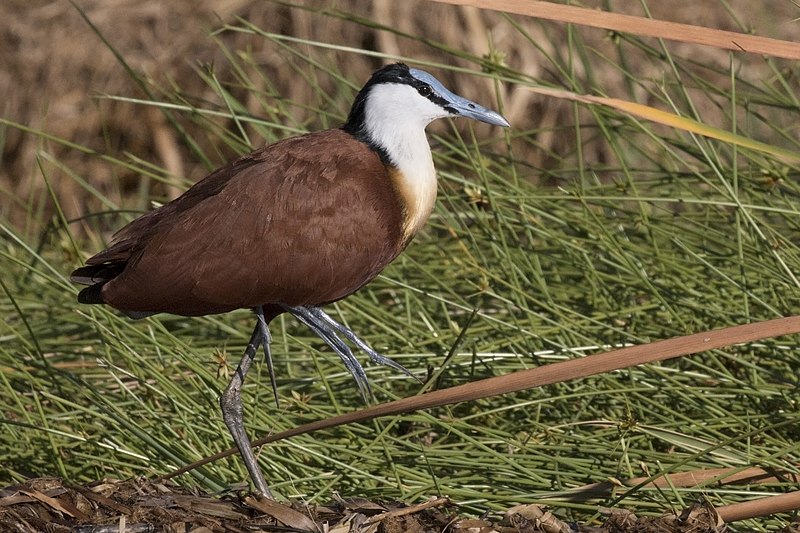
The African Jacana is a charming wader belonging to the family of Jacanidae, mostly found in sub-Saharan Africa.
It has long toes and claws that allow it to walk on floating vegetation in shallow lakes which form its preferred habitat.
The bird was officially described by Johann Friedri in 1789 with an interesting origin and pronunciation for its name -Jacanidae.
This aquatic bird is known for its striking plumage features like yellow crowns and black wings marked with chestnut brown stripes across them, making them look even more attractive when they spread their wing feathers during courtship displays.
They feed mainly on insects, tadpoles, frogs etc., skimming nearby water surface or plucking prey from vegetation as they wander around these wetlands areas.Scientific classification:
| Kingdom | Animalia |
| Phylum | Chordata |
| Class | Aves |
| Order | Charadriiformes |
| Family | Jacanidae |
| Genus | Actophilornis |
| Species | A. africanus |
13. Goliath Heron
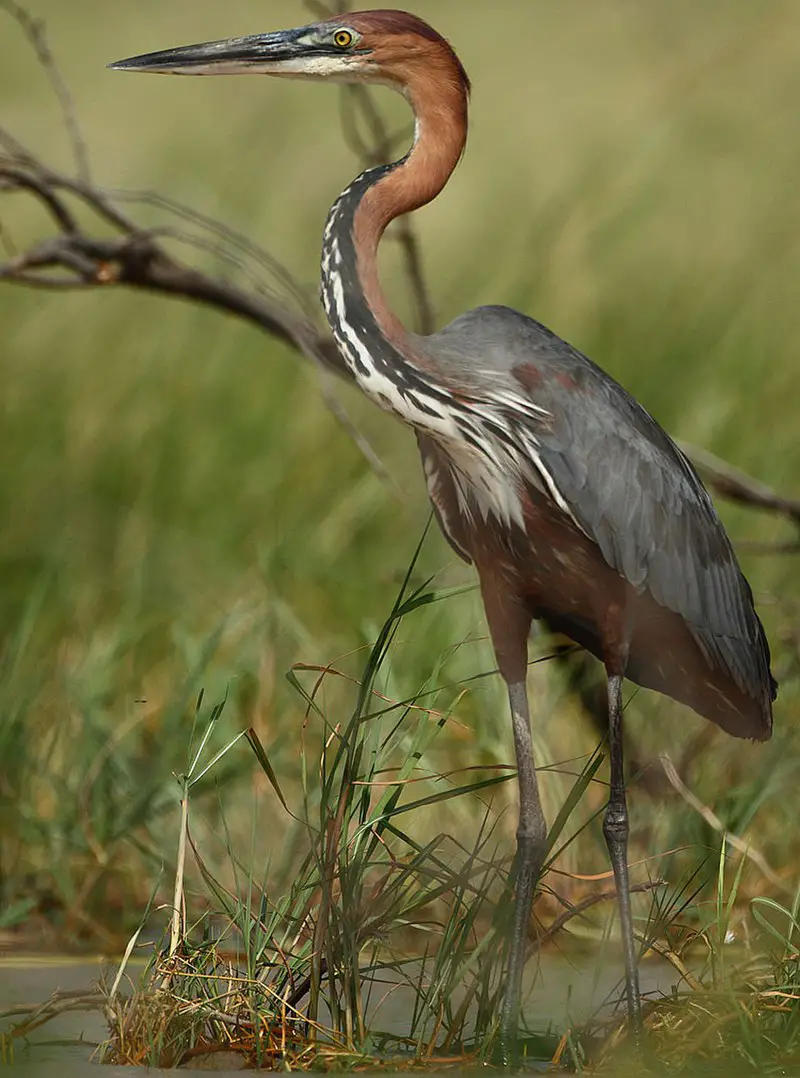
The Goliath Heron is the world’s largest living heron species, found in sub-Saharan Africa and smaller numbers in Southwest and South Asia. It stands up to 5 feet tall with a wingspan of over 6 feet wide.
Its bill is long and yellowish-orange while its head has white plumes that point backward along its neck. Its back, scapulars, tail feathers are dark gray or black while it has lighter gray wing coverts and primaries.
The body plumage ranges from light grey to brownish grey depending on age; younger birds have more whitish coloration than adults do.
This bird preys on fish as well as amphibians, crustaceans, insects, reptiles and small mammals near water sources such as wetlands or lakesides—it also visits agricultural land for carrion at times.Scientific classification:
| Kingdom | Animalia |
| Phylum | Chordata |
| Class | Aves |
| Order | Pelecaniformes |
| Family | Ardeidae |
| Genus | Ardea |
| Species | A. goliath |
Also Featured In: Birds You’ll Find in Kenya Safari, Large African Birds You Need to Know
14. Hamerkop
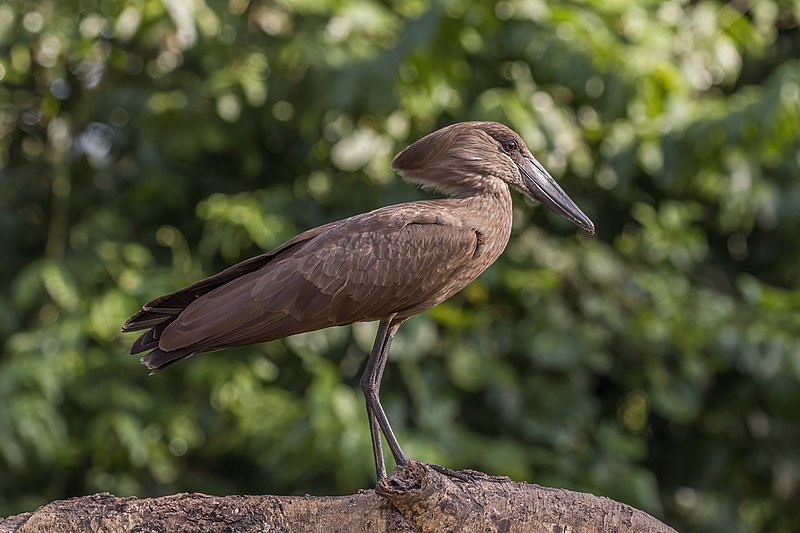
The Hamerkop is a unique wading bird found across sub-Saharan Africa and as far east as India.
It has an unmistakable silhouette, with its long bill topped by a crest at the back of its head that gives it the look of a hammerhead shark.
Its plumage consists mainly of browns and greys, providing excellent camouflage in reed beds.
The species was once classified alongside storks but is now believed to be closely related to pelicans and shoebills instead.
This medium-sized bird feeds on insects, fish, frogs or small reptiles which it captures from shallow water or plucks from trees near bodies of water.
Despite being considered ‘unlucky’ by some cultures due to superstition surrounding their appearance they are actually quite important for controlling populations of certain pests.Scientific classification:
| Kingdom | Animalia |
| Phylum | Chordata |
| Class | Aves |
| Order | Pelecaniformes |
| Family | Scopidae |
| Genus | Scopus |
| Species | S. umbretta |
15. Black-Headed Gonolek
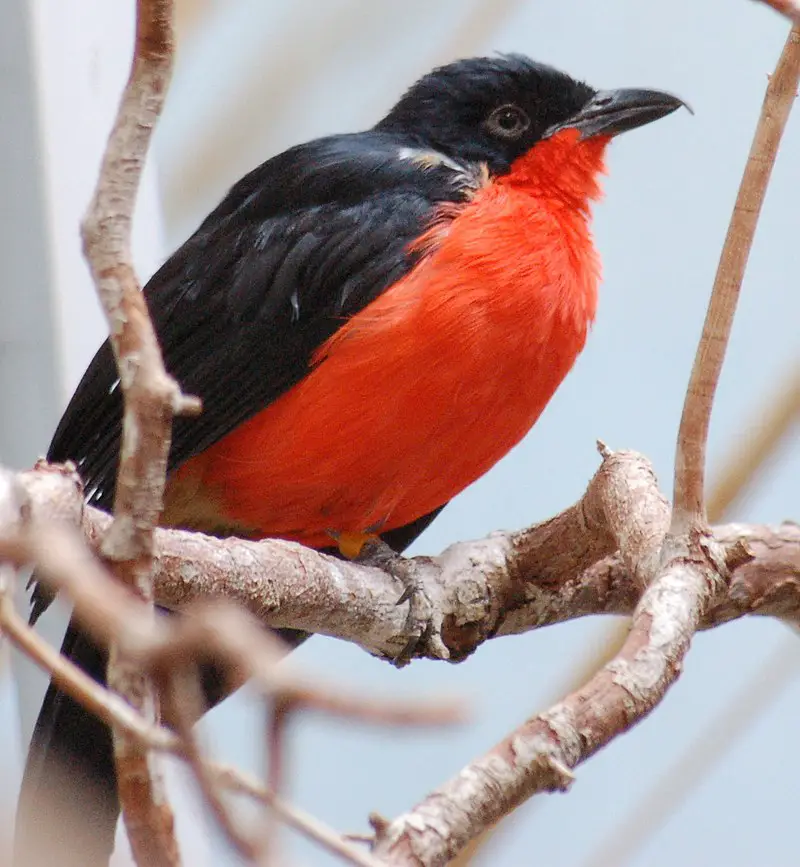
The Black-headed Gonolek is a beautiful bird found in Central and East Africa. It belongs to the Malaconotidae family, which includes birds such as shrikes and bushshrikes.
These birds are usually encountered singly or in pairs, perched atop shrubs or trees. They have black heads with white streaks running through them along with red chests, brown wings and tails, yellow bellies and grayish-white legs.
The diet of these birds consists mostly of insects but they also eat small fruits from time to time. As their natural habitats consist of dry savannas, moist shrublands or seasonal forests; it makes for an ideal breeding ground for these species as there’s plenty of food available throughout the year.Scientific classification:
| Kingdom | Animalia |
| Phylum | Chordata |
| Class | Aves |
| Order | Passeriformes |
| Family | Malaconotidae |
| Genus | Laniarius |
| Species | L. erythrogaster |
16. Chocolate-Backed Kingfisher
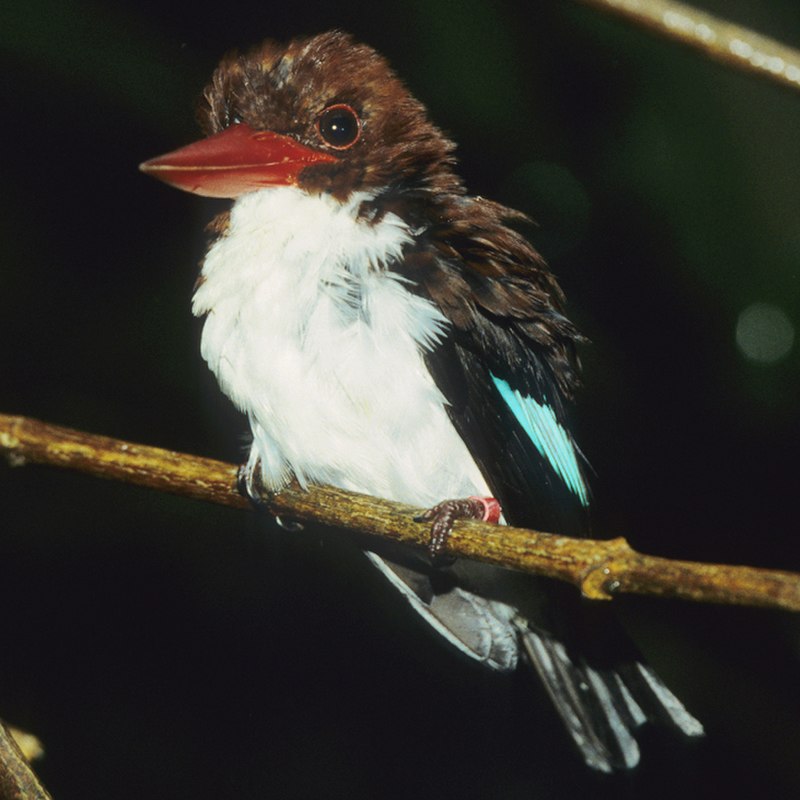
The Chocolate-backed Kingfisher is a beautiful sight to behold. It has dark upperparts and pure white underparts, as well as a black head and hind neck, brownish-black mantle, and brilliant iridescent blue rump.
This species of kingfisher can be found in western Sub-Saharan Africa where it usually inhabits open woodland or savanna habitats near water bodies like rivers or marshes.
They are solitary birds that feed on small fish they catch by diving into the water from an elevated perch.
These stunning birds also perform elaborate courtship displays consisting of aerial acrobatics while making loud calls to attract potential mates during breeding season.Scientific classification:
| Kingdom | Animalia |
| Phylum | Chordata |
| Class | Aves |
| Order | Coraciiformes |
| Family | Alcedinidae |
| Subfamily | Halcyoninae |
| Genus | Halcyon |
| Species | H. badia |
Also Featured In: Common Tropical Rainforest Birds,
17. Abyssinian Ground Hornbill
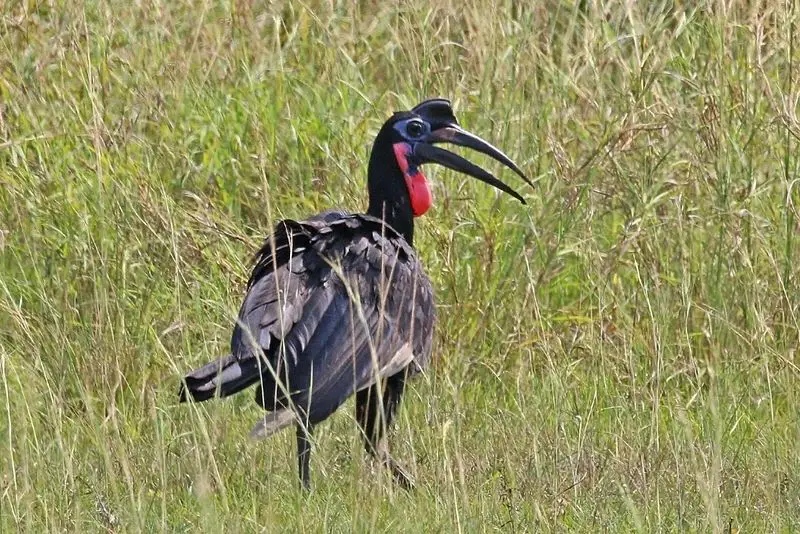
The Abyssinian ground hornbill is an African bird, found mainly north of the equator. It is one of two species of ground hornbills and second largest amongst all African Hornbills only surpassed by its slightly larger relative – southern ground hornbill.
This impressive bird was described by Georges-Louis Leclerc, Comte de Buffon in 1780’s and has a unique appearance with striking red facial skin surrounding bright yellow eyes.
The male birds are bigger than females and have different plumage colours (black/blue feathers) compared to their female companions who tend to be brownish grey.
They feed on insects, small mammals or reptiles which they hunt from the sky or find on land using their powerful feet for digging up prey items hidden underneath soil or sand.Scientific classification:
| Kingdom | Animalia |
| Phylum | Chordata |
| Class | Aves |
| Order | Bucerotiformes |
| Family | Bucorvidae |
| Genus | Bucorvus |
| Species | B. abyssinicus |
18. Pied Kingfisher
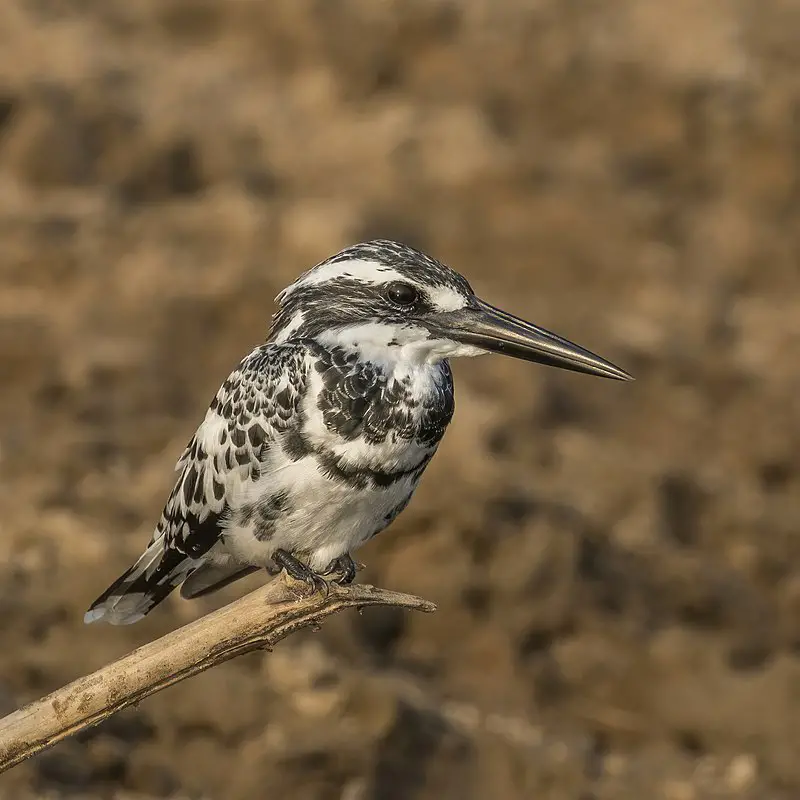
The Pied Kingfisher is a species of water kingfisher found in Africa and Asia. It has black and white plumage, with males sporting a double band across the breast while females have one single band.
This bird makes its presence known by hovering over clear waters before diving for fish – making it easily recognizable.
The diet consists mostly of small aquatic animals such as frogs, crustaceans and insects, but they also consume some plant matter like seeds or fruits occasionally.
The pied kingfisher nests near bodies of water where it can feed off smaller creatures that dwell there; usually in burrows dug into riverbanks or on floating vegetation close to shorelines.
With their distinct colors and behavior patterns these birds make an interesting addition to any wildlife enthusiast’s list.Scientific classification:
| Kingdom | Animalia |
| Phylum | Chordata |
| Class | Aves |
| Order | Coraciiformes |
| Family | Alcedinidae |
| Subfamily | Cerylinae |
| Genus | Ceryle F. Boie, 1828 |
| Species | C. rudis |
19. Black-And-White-Casqued Hornbill
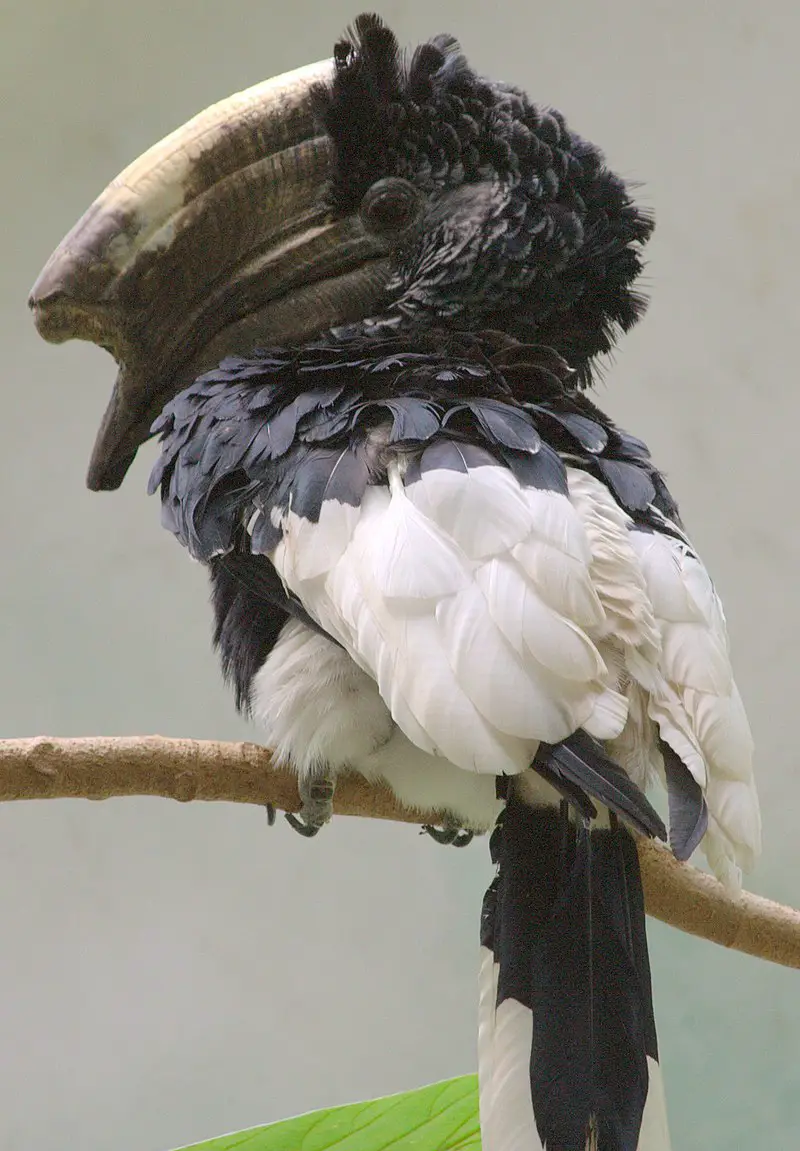
The Black-and-white-casqued Hornbill is a large, beautiful bird of black and white feathers. It has an oversized bill with a prominent casque on top.
The female is slightly smaller in size compared to the male and its casque is much smaller as well.
This species mates for life and builds their nest inside suitable tree cavities where they lay two eggs at once.
These birds are omnivorous; eating fruits, insects, small reptiles and other animals depending upon their availability near the nesting sites or during migrations when searching for food sources along the way.
They fly swiftly but soar gracefully through open skies displaying stunning beauty with each flap of their wings.Scientific classification:
| Kingdom | Animalia |
| Phylum | Chordata |
| Class | Aves |
| Order | Bucerotiformes |
| Family | Bucerotidae |
| Genus | Bycanistes |
| Species | B. subcylindricus |
20. Kori Bustard
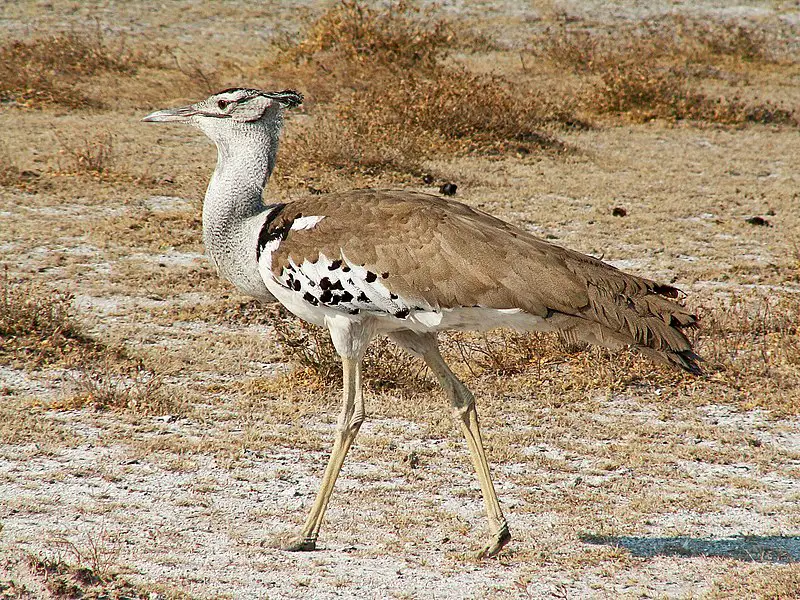
The Kori Bustard is the largest flying bird native to Africa and part of the bustard family. It has a large body, with males reaching up to 20kg in weight – making it one of the heaviest living animals capable of flight.
Its range covers most African countries from Ethiopia all the way down south towards South Africa.
The Kori Bustard is omnivorous and feeds on insects, small lizards, seeds, fruit and even carrion if available.
Their feathers are mostly brownish grey while their heads have black stripes running over them which makes them easily identifiable when seen in its natural habitat.
They usually live alone or in pairs during breeding season but will gather into larger groups at other times throughout their lives; typically nesting on dry open grasslands near water sources for easy access to food and drink.Scientific classification:
| Kingdom | Animalia |
| Phylum | Chordata |
| Class | Aves |
| Order | Otidiformes |
| Family | Otididae |
| Genus | Ardeotis |
| Species | A. kori |
21. Handsome Spurfowl
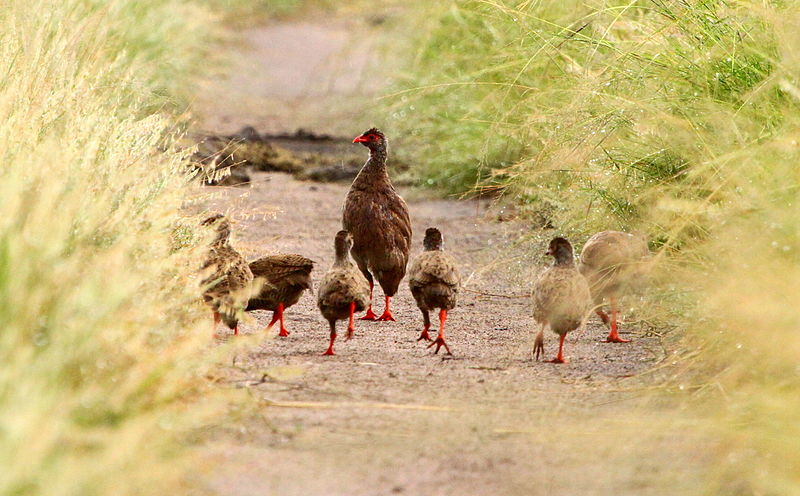
The Handsome Spurfowl is a beautiful bird found in forests across Africa. It has reddish-brown plumage, a grey head and red bill and legs that give it an attractive appearance.
Its eyes have brown irises with bare red orbital skin around them, while its underside is rufous grey. Both sexes are similar in size but the female may be slightly smaller than the male.
The young birds have duller feathers compared to adults. This species typically feeds on seeds, insects, fruits and other small creatures found near ground level – making it quite easy for people to spot when out walking or wildlife watching.Scientific classification:
| Kingdom | Animalia |
| Phylum | Chordata |
| Class | Aves |
| Order | Galliformes |
| Family | Phasianidae |
| Genus | Pternistis |
| Species | P. nobilis |
Also Featured In: Birds of Nyungwe Forest National Park,
22. Red-Throated Bee-Eater
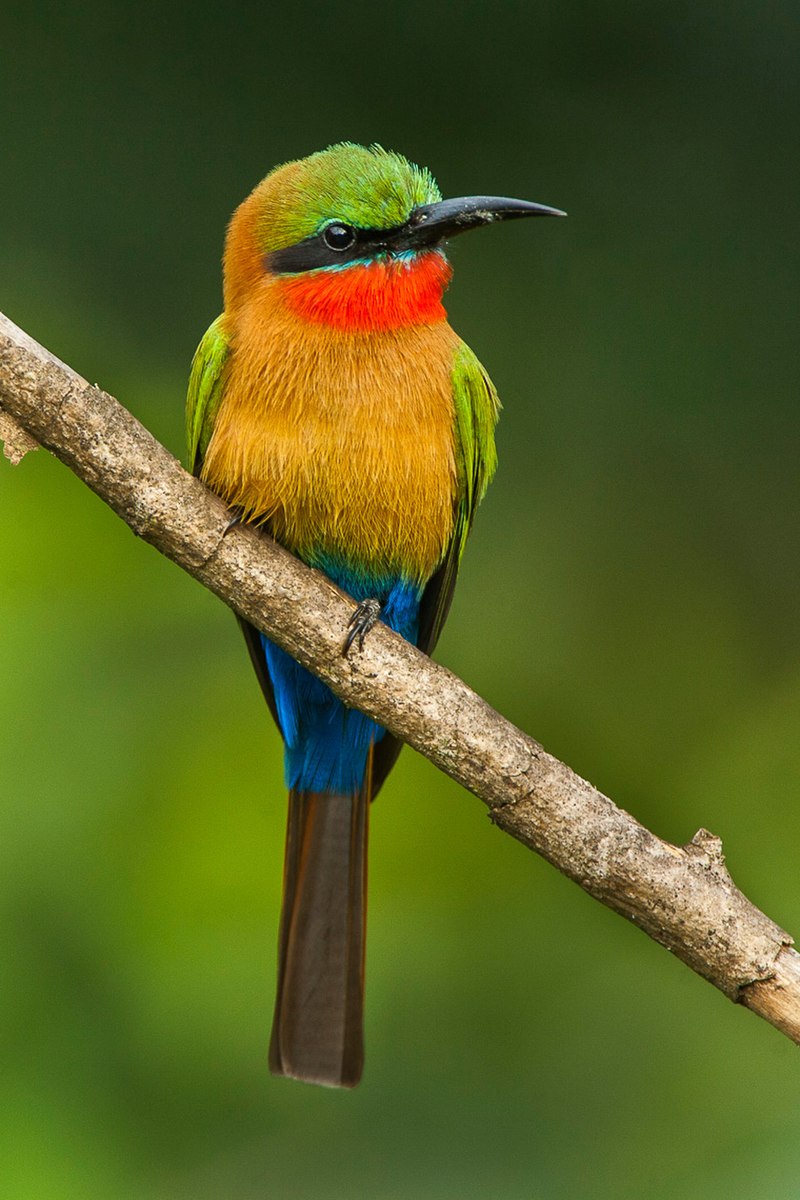
The Red-throated Bee-eater is a beautiful species of bird found in tropical Africa. It has bright red feathers covering its throat, giving it a distinct look.
Its body is mostly brown with white stripes and its wings are dark blue on the tips.
This species enjoys an extensive range throughout countries like Benin, Burkina Faso, and Togo to name just a few.
These birds feed mainly on insects that they catch in midair or from nearby foliage during their hunting flights over open country habitats such as woodlands and savannas.
While not much else is known about this particular type of bee-eater, these colorful creatures have surely become quite popular due to their striking beauty.Scientific classification:
| Kingdom | Animalia |
| Phylum | Chordata |
| Class | Aves |
| Order | Coraciiformes |
| Family | Meropidae |
| Genus | Merops |
| Species | M. bulocki |
23. Malachite Kingfisher
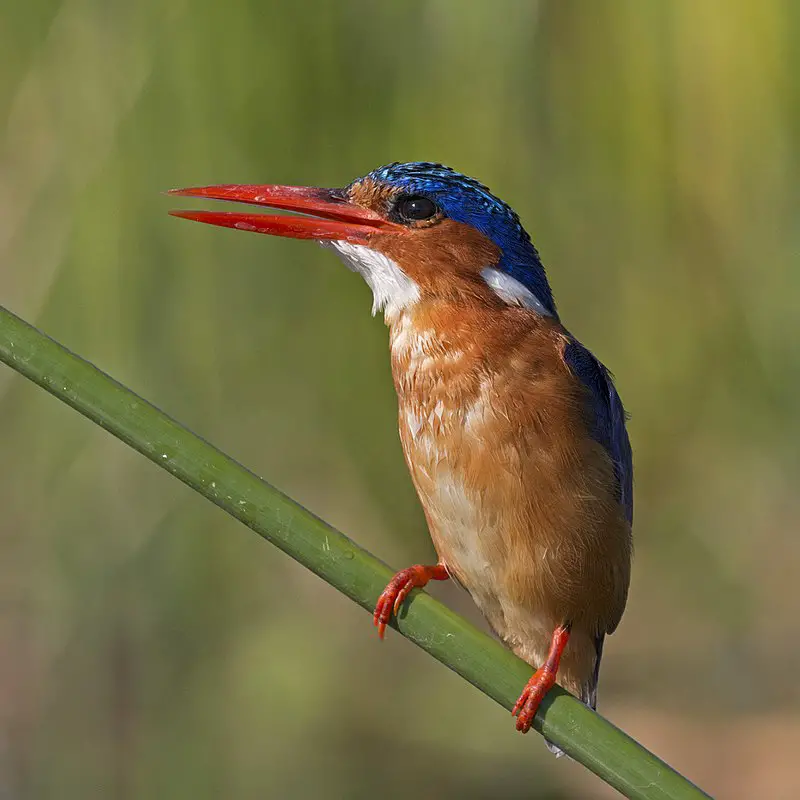
The Malachite Kingfisher is a beautiful bird found in Africa south of the Sahara. It has bright blue wings and tail, with greenish-black upperparts, white chin and breast and orange lower belly.
The species was first described by German naturalist Peter Simon Pallas in 1764 who gave it its binomial name “Alcedo cristata”.
This kingfisher typically inhabits rivers where it feeds on fish, frogs as well as aquatic invertebrates like crustaceans and insects.
Although mainly resident throughout the year, some do make seasonal movements due to climate changes.
These birds are monogamous during breeding season which usually lasts from August till October when they build their nests inside river banks or overhanging vegetation near water bodies.Scientific classification:
| Kingdom | Animalia |
| Phylum | Chordata |
| Class | Aves |
| Order | Coraciiformes |
| Family | Alcedinidae |
| Subfamily | Alcedininae |
| Genus | Corythornis |
| Species | C. cristatus |
24. Jacanas
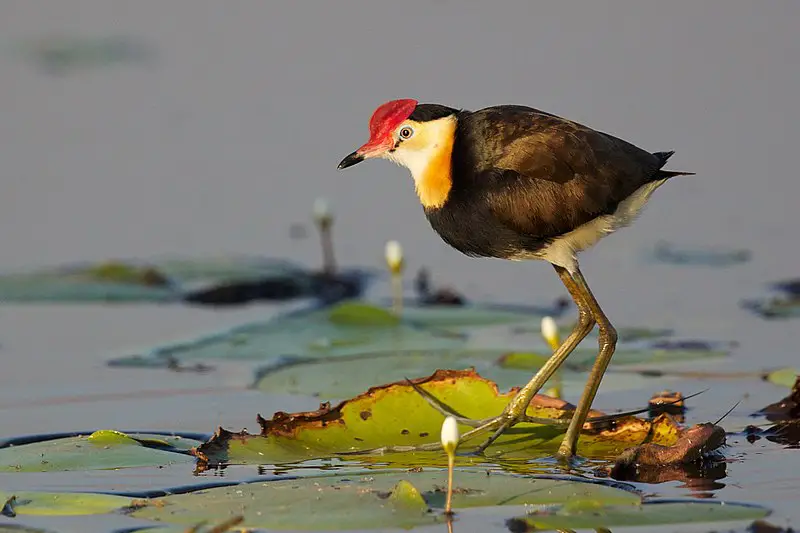
Jacanas are tropical waders belonging to the Jacanidae family. They have distinctive elongated toes and toenails which help them forage on floating or semi-emergent aquatic vegetation.
This adaptation gives them their nickname “Jesus birds” as they seem to be able to walk on water.
The female jacanas are also unique amongst bird species in that they take charge of nest building, incubation and caring for young while males perform courtship displays.
These unusual birds can be found throughout the world’s tropical regions where they inhabit wetlands such as swamps, marshes and shallow lakes with lily pads.
With a wide variety range due their special adaptations these beautiful creatures will surely continue living life at ease around our planet’s warmest waters.Scientific classification:
| Kingdom | Animalia |
| Phylum | Chordata |
| Class | Aves |
| Order | Charadriiformes |
| Suborder | Thinocori |
| Family | Jacanidae Stejneger, 1885 |
25. Verreaux’s Eagle-Owl
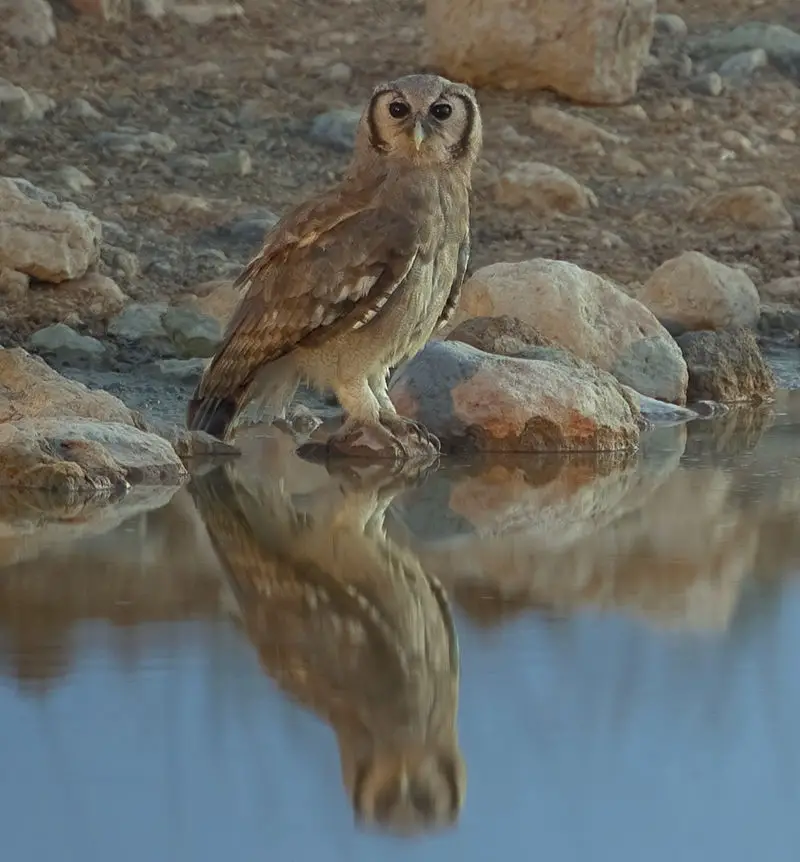
Verreaux’s eagle-owl is a magnificent bird that can be found in dry, wooded savannas of sub-Saharan Africa. It is the largest African owl and measures up to 66 cm (26 inches) long.
This majestic creature has grey plumage with white spots on its back and wings, while its face is covered by an impressive facial disk.
Its eyes are yellowish orange in color, surrounded by white feathers which give it a striking appearance.
These birds hunt mostly during the night but may occasionally also do so during daylight hours when food becomes scarce or if they have recently hatched young ones who need feeding.
Verreaux’s eagle-owls live alone or in pairs for much of the year until breeding season comes around after which two eggs will be laid at once and incubated for about 30 days before hatching into fluffy chicks.Scientific classification:
| Kingdom | Animalia |
| Phylum | Chordata |
| Class | Aves |
| Order | Strigiformes |
| Family | Strigidae |
| Genus | Bubo |
| Species | B. lacteus |
Also Featured In: Birds that You’ll Find in Kruger national park,
26. Pink-Backed Pelican
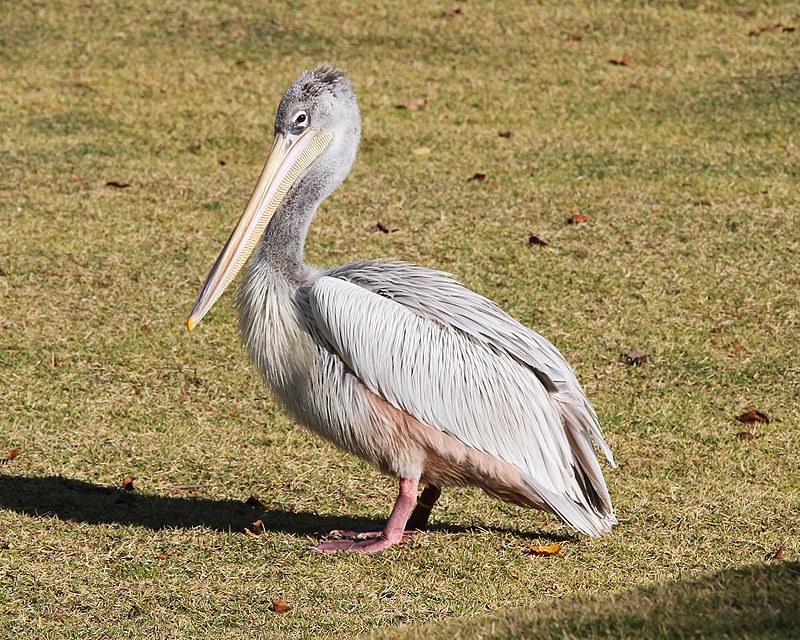
The Pink-backed Pelican is a beautiful bird of the pelican family, found in Africa and southern Arabia.
They are resident breeders that inhabit swamps and shallow lakes, but were once seen in Madagascar as well.
It was formally described by German naturalist Johann Friedrich Gmelin back in 1789.
These birds have unique pink feathers on their backs which gives them their name along with grey or white heads with black wing tips.
They use their long beaks to scoop up fish from the water then drain out excess water before swallowing it whole.
The diet of these birds consists mainly of small fish like anchovies, sardines, and other types offish they can find near the surface of rivers or lakes.
With its long wingspan ranging between 2 – 3 feet (60 – 90 cm), this species has adapted perfectly for gliding over bodies of water while searching for prey to eat.Scientific classification:
| Kingdom | Animalia |
| Phylum | Chordata |
| Class | Aves |
| Order | Pelecaniformes |
| Family | Pelecanidae |
| Genus | Pelecanus |
| Species | P. rufescens |
27. African Openbill
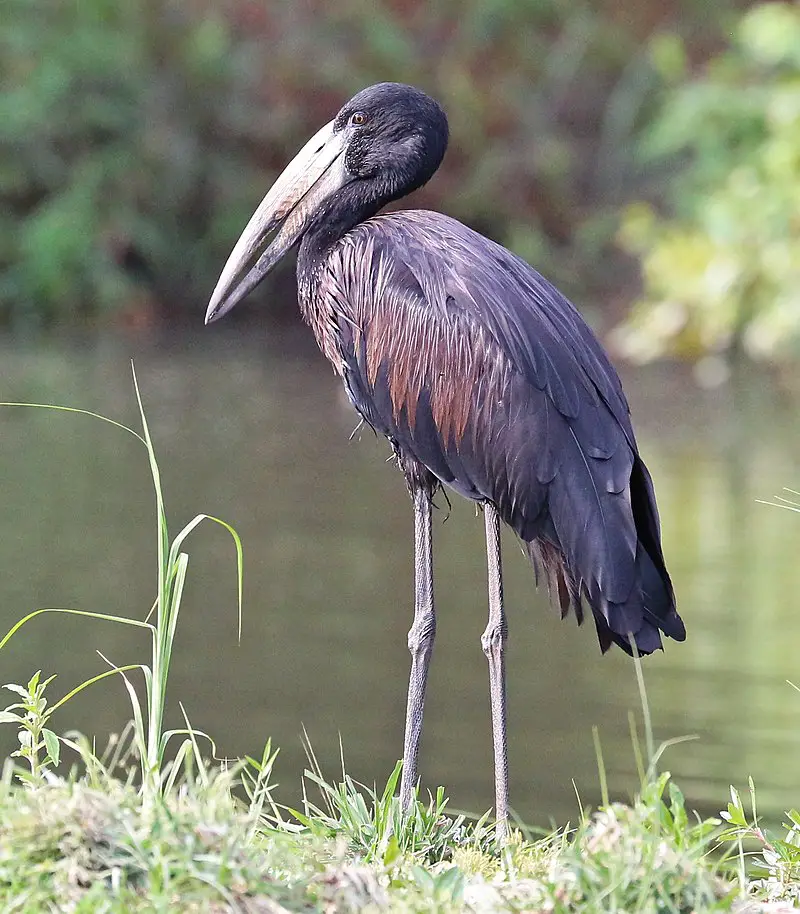
The African openbill is a species of stork found in Sub-Saharan Africa and western Madagascar.
It has a patchy distribution but is generally considered to be common or locally abundant, with two subspecies – A. l. lamelligerus on the continent and A. l. batesi in some parts of Madagascar’s west coast region.
This bird stands up to 75 cm tall and has an impressive bill that looks like it’s been cut down the middle when opened wide.
Its black feathers are contrasted by bright yellow legs, pinkish red eyes, and white wing tips which make it easily recognizable from other species of birds.
It feeds mainly on snails found amongst aquatic vegetation so can often be seen wading through shallow waters looking for food as well as perched atop trees scanning its surroundings for prey items.Scientific classification:
| Kingdom | Animalia |
| Phylum | Chordata |
| Class | Aves |
| Order | Ciconiiformes |
| Family | Ciconiidae |
| Genus | Anastomus |
| Species | A. lamelligerus |
28. Water Thick-Knee
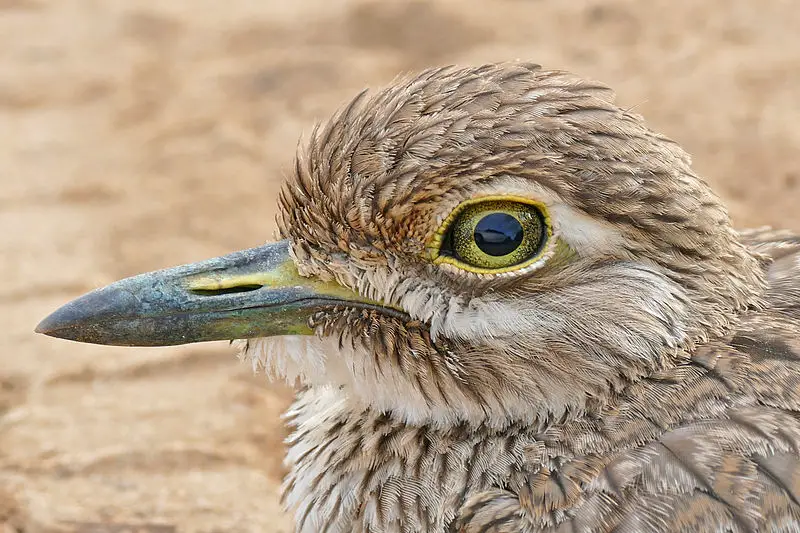
The Water thick-knee is a species of bird belonging to the Burhinidae family. It has a wide distribution in sub-Saharan Africa, where it can be found near waterbodies such as rivers, lakes and wetlands.
Its plumage is dark brown above with white spots on its wings, while below it is mostly greyish or whitish.
The bill is long and straight with yellow legs and feet. During breeding season they are more vocal than usual making loud calls during the night time hours that sound like “keh keh”.
This bird feeds mainly on insects but also takes small reptiles, crustaceans and molluscs from shallow waters when available.
Breeding pairs construct scrapes within grassy areas which they use for nesting sites during the dry season months between July to September depending on locationScientific classification:
| Kingdom | Animalia |
| Phylum | Chordata |
| Class | Aves |
| Order | Charadriiformes |
| Family | Burhinidae |
| Genus | Burhinus |
| Species | B. vermiculatus |
29. Greater Painted-Snipe
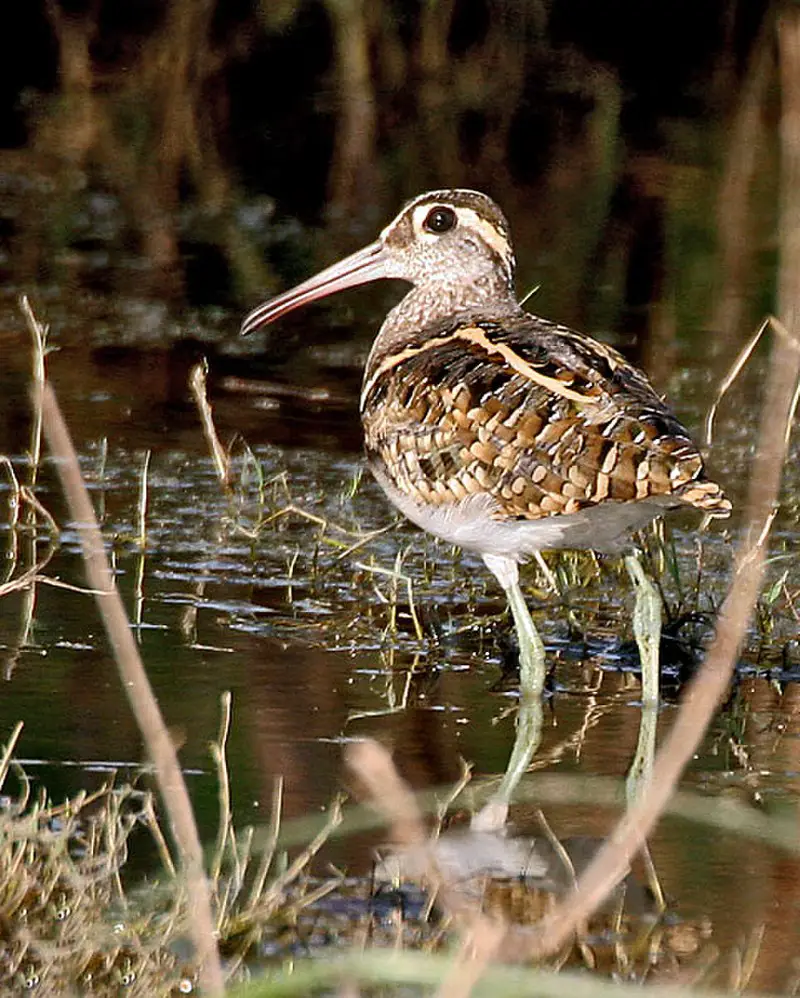
The Greater Painted-snipe is a medium-sized, plump wading bird found in marshes throughout Africa, South Asia and Southeast Asia.
It has distinctive features that make it stand out from its peers: a long reddish brown bill slightly curved at the tip with an eye patch of white or pinkish coloration; rounded wings speckled with buff spots; and a short tail.
The breast of this species has extensive white plumage which extends up around the top of its folded wing.
With its unique appearance, this avian beauty stands out among other birds in wetland habitats.Scientific classification:
| Kingdom | Animalia |
| Phylum | Chordata |
| Class | Aves |
| Order | Charadriiformes |
| Family | Rostratulidae |
| Genus | Rostratula |
| Species | R. benghalensis |
30. African Skimmer
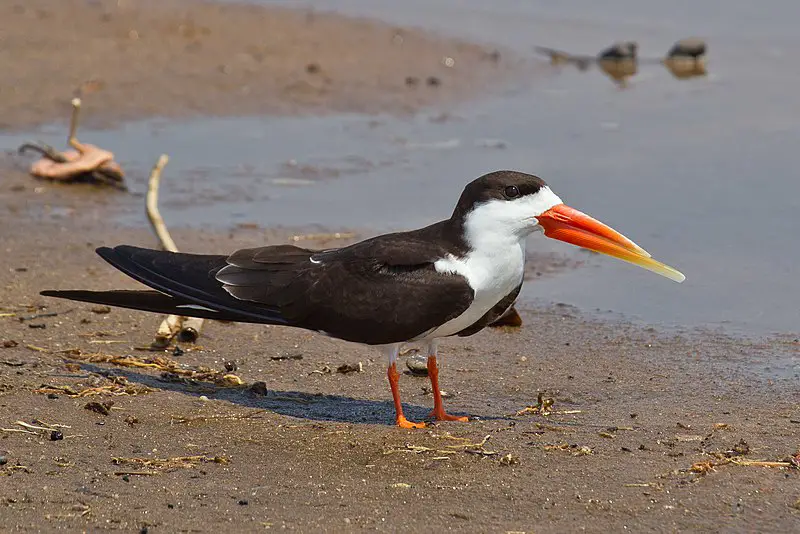
The African skimmer is a species of bird found in Sub-Saharan Africa along rivers, lakes and lagoons. It has long wings with a black back and crown.
The forehead and body are white, while the beak is bright orange but ending in yellow or black depending on its maturity level.
This fascinating creature feeds by skimming the surface of water for small fish which it eats whole head first.
Its feet have special adaptations to allow them to swim better rather than just walk on land like other birds do.
They form large colonies during breeding season usually near their food sources where they also lay eggs within shallow ground nests made out of mud, pebbles and grasses as well as line them with feathers from other birds.Scientific classification:
| Kingdom | Animalia |
| Phylum | Chordata |
| Class | Aves |
| Order | Charadriiformes |
| Family | Laridae |
| Genus | Rynchops |
| Species | R. flavirostris |
31. Grebes
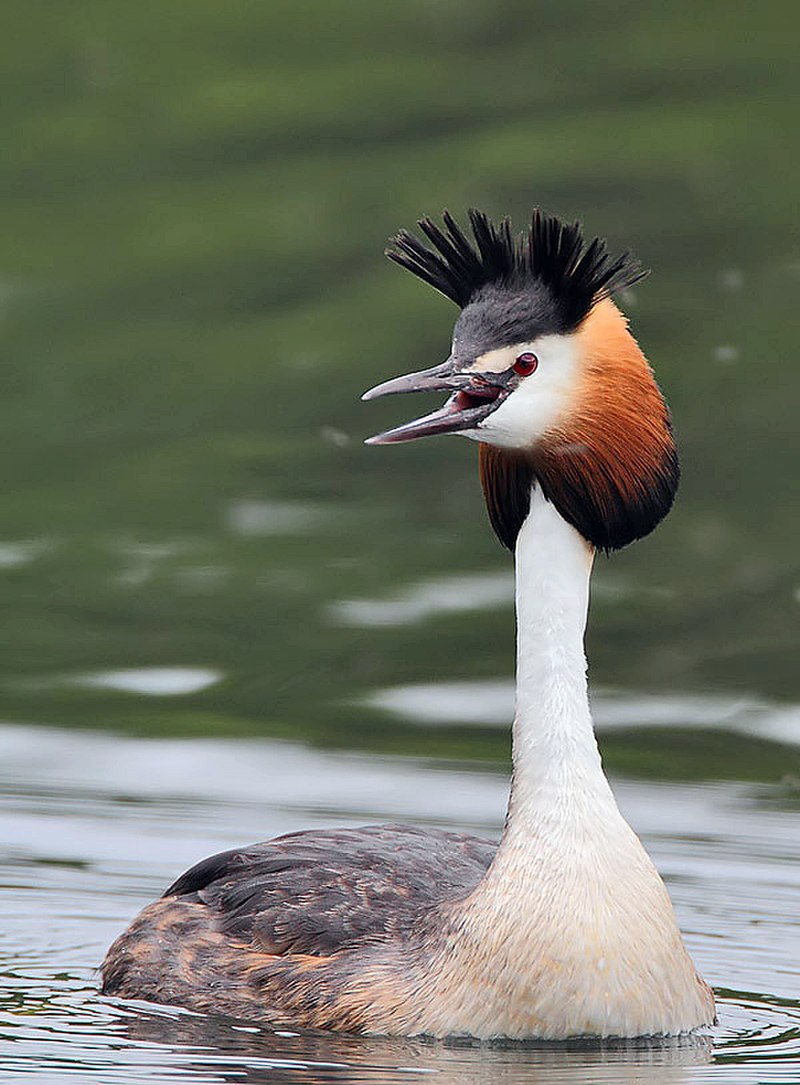
Grebes are a type of diving bird found in freshwater habitats around the world. They belong to the order Podicipediformes and have 22 species that exist across six genera.
Some species can also be found in marine environments during their migration or winter season, and some even live flightless lives on stable lakes.
Grebes vary greatly between regions; for example, they range from 4-32 inches long with anywhere from 8-30 ounces of weight depending on which species it is.
Their plumage may be black, browns/grays or whites but usually consist of bright colors such as yellows, blues and greens while underwater they use these feathers to help them streamline through the water quickly.Scientific classification:
| Kingdom | Animalia |
| Phylum | Chordata |
| Class | Aves |
| Clade | Neoaves |
| Clade | Mirandornithes |
| Order | Podicipediformes Fürbringer, 1888 |
| Family | Podicipedidae Bonaparte, 1831 |
32. Northern Carmine Bee-Eater
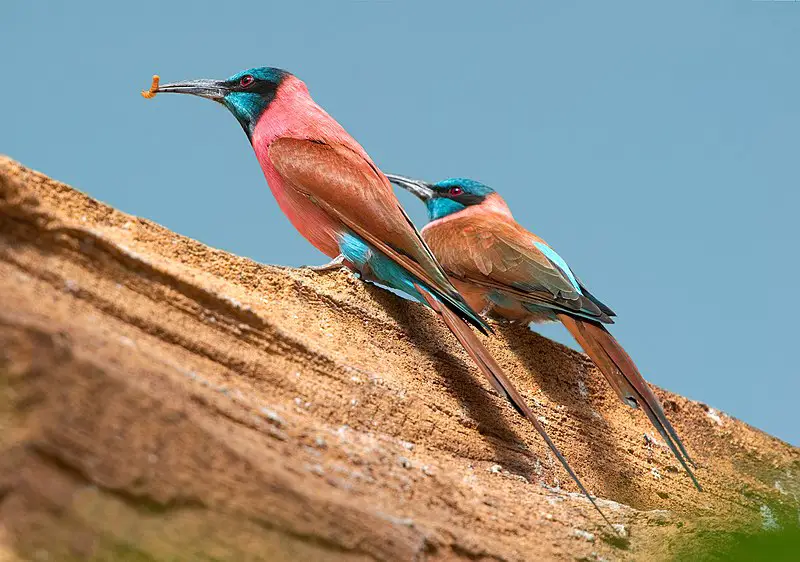
The Northern Carmine Bee-eater is a beautiful bird with striking colors. It has bright red and blue plumage, with the throat being predominantly carmine in color.
This species of bee-eater can be found throughout northern tropical Africa, from Senegal east to Somalia, Ethiopia and Kenya.
It was previously assumed to be closely related to the Southern Carmine Bee-eater which has a scarlet colored throat instead of blue as seen in this species.
The Northern Carmine Bee-Eater feeds on flying insects such as bees and other small creatures that it catches midair using its sharp claws and bill for grabbing them quickly before they escape.Scientific classification:
| Kingdom | Animalia |
| Phylum | Chordata |
| Class | Aves |
| Order | Coraciiformes |
| Family | Meropidae |
| Genus | Merops |
| Species | M. nubicus |
33. Jackson’s Spurfowl
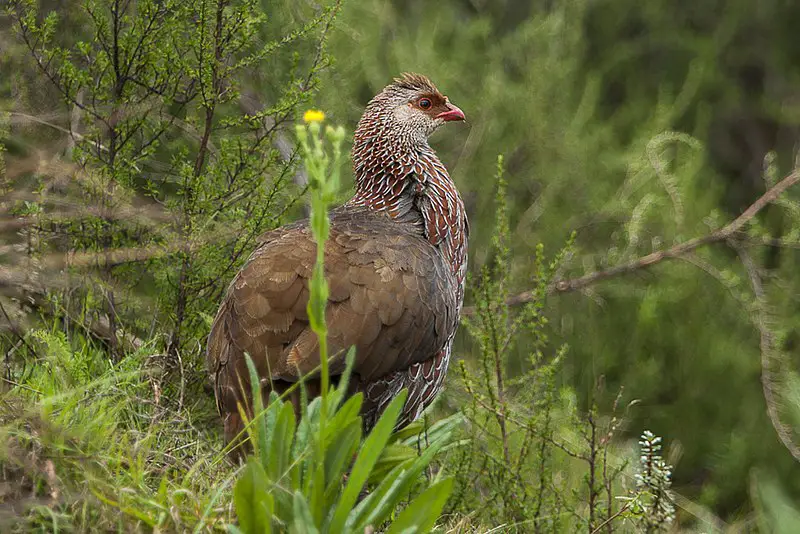
Jackson’s spurfowl, also known as Jackson’s francolin, is a species of bird found in Kenya and Uganda. It prefers mountainous forests and stands of bamboo for its habitat.
This species was named after the English administrator and ornithologist Frederick John Jackson who discovered it in 1891.
The males are blackish-brown while females have paler tan plumage with barring on their flanks – both sexes have white throat patches which become brighter during breeding season.
They feed mainly on insects but also consume some plant material such as flowers, buds or fruits when available.
Despite being hunted by humans for sport or food due to its large size, this species remains fairly common across much of its range thanks to ongoing conservation efforts protecting their habitats from destruction or human disturbance activities like logging and farming operations that could reduce suitable areas for them to live in safely.Scientific classification:
| Kingdom | Animalia |
| Phylum | Chordata |
| Class | Aves |
| Order | Galliformes |
| Family | Phasianidae |
| Genus | Pternistis |
| Species | P. jacksoni |
34. Glossy Ibis
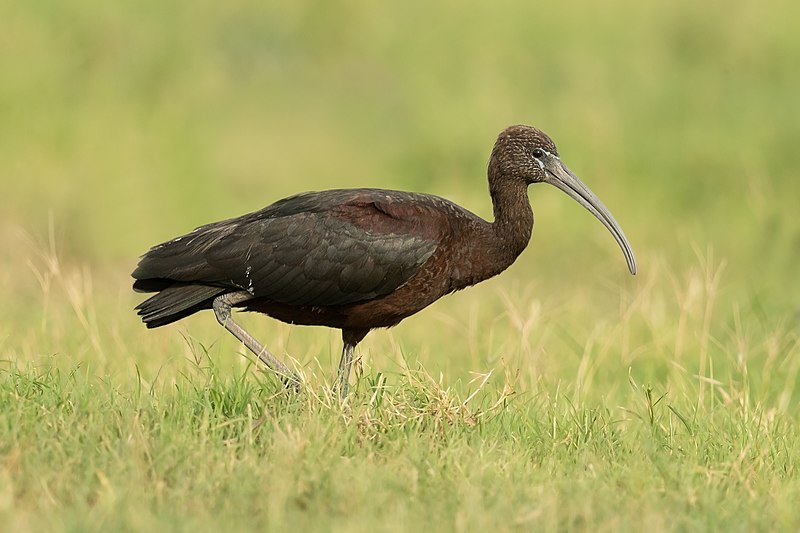
The Glossy Ibis is a water bird that belongs to the family Threskiornithidae. It has an unique bill in the shape of a sickle, which gave it its scientific name – Plegadis falcinellus.
It can be found widely across Europe, Asia and Africa, with scattered nesting sites in warm regions.
Its feathers are black-brown on top and chestnut brown from below; their wings have glossy greenish-purple sheen when seen from afar.
They mainly feed on small insects like grasshoppers, spiders or earthworms as well as crustaceans or amphibians caught while wading through shallow waters.
During breeding season they also consume plant material such as rice grains or corn kernels provided by humans near habitat areas where they nest.Scientific classification:
| Kingdom | Animalia |
| Phylum | Chordata |
| Class | Aves |
| Order | Pelecaniformes |
| Family | Threskiornithidae |
| Genus | Plegadis |
| Species | P. falcinellus |
Also Featured In: Turkey Birds You Should Know, Water Birds Live around Us
35. Crowned Cranes
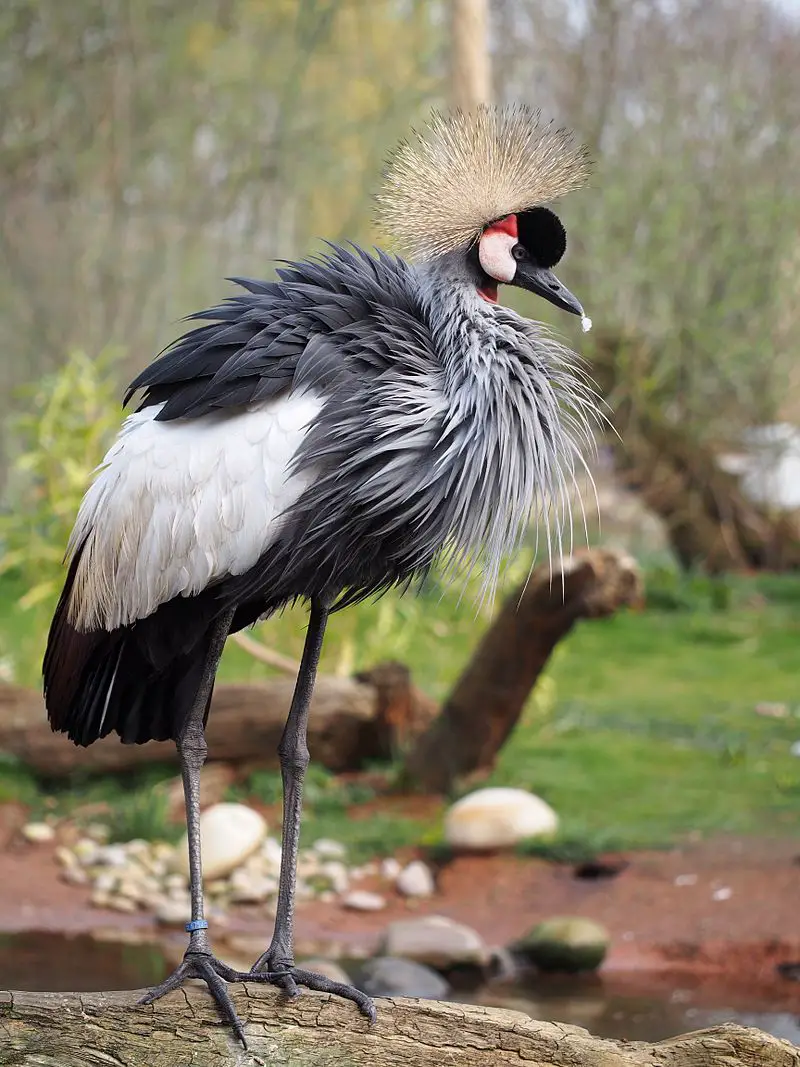
Crowned cranes, of the genus Balearica, are two species of birds in the crane family Gruidae. Found exclusively south of the Sahara Desert in Africa, they have adapted to nest in trees which sets them apart from other cranes who typically build on land.
The black crowned crane (B. pavonina) and grey crowned crane (B. regulorum) are both beautiful birds with unique feather patterns that distinguish them from each other; as well as a variety of calls used for communication between mates or flocks during migration.
They feed primarily on insects and grains but will also consume small animals such as frogs when available- making them omnivorous creatures.
Overall these gorgeous feathered friends make an important contribution to their ecosystems by helping keep populations balanced through their diet choices – truly majestic creatures indeed.Scientific classification:
| Kingdom | Animalia |
| Phylum | Chordata |
| Class | Aves |
| Order | Gruiformes |
| Family | Gruidae |
| Subfamily | Balearicinae |
| Genus | Balearica Brisson, 1760\ |
36. African Emerald Cuckoo
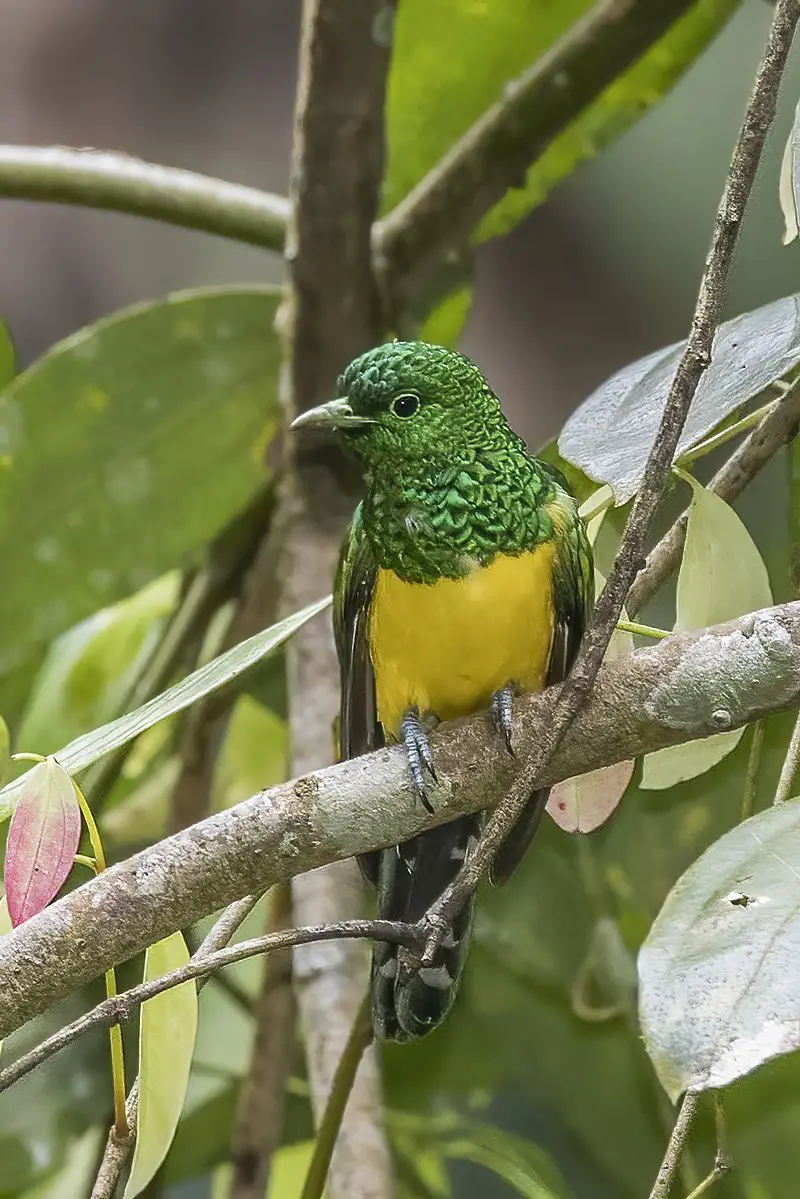
The African emerald cuckoo is a species of Old World cuckoo that can be found across much of sub-Saharan Africa.
It has four unique subspecies, C.c. cupreus, C.c sharpei, C.c intermedius and insularum which have adapted to their respective areas in the continent over time and are distinguishable by minor differences such as size or plumage colouration.
This bird feeds mainly on arthropods but will also consume fruit from trees like mangoes when available during its breeding season spanning from December to April depending upon location.
The female lays eggs directly into other birds’ nests without them knowing for it raise her own young with no effort required by her; this behavior gives the species its name ‘Cuckoo’ as it is thought to mimic the sound made by these birds within their habitat.Scientific classification:
| Kingdom | Animalia |
| Phylum | Chordata |
| Class | Aves |
| Order | Cuculiformes |
| Family | Cuculidae |
| Genus | Chrysococcyx |
| Species | C. cupreus |
37. Fox’s Weaver
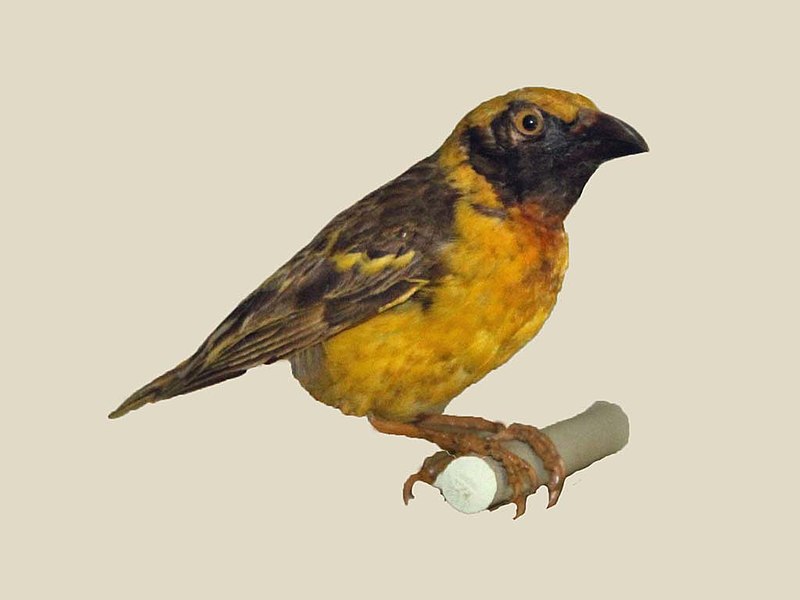
Fox’s weaver is a species of bird that can only be found in Uganda. As it lives in moist savanna, subtropical or tropical seasonally wet or flooded lowland grasslands, and swamps its habitat has become threatened by the loss of such environments due to human activities.
It belongs to the family Ploceidae which consists mostly of seed-eating birds with specialized bills for handling their food commodities.
This particular type of weaver stands out as it builds intricate nests made from leaves woven together using its long bill along with other materials like spider webs, small twigs and bark strips making them look quite unique compared to those built by other types of birds within this family group.
Fox’s Weaver is certainly an amazing creature but unfortunately continues to face threats today so conservation efforts must continue if these beautiful creatures are going to survive.Scientific classification:
| Kingdom | Animalia |
| Phylum | Chordata |
| Class | Aves |
| Order | Passeriformes |
| Family | Ploceidae |
| Genus | Ploceus |
| Species | P. spekeoides |
38. Regal Sunbird
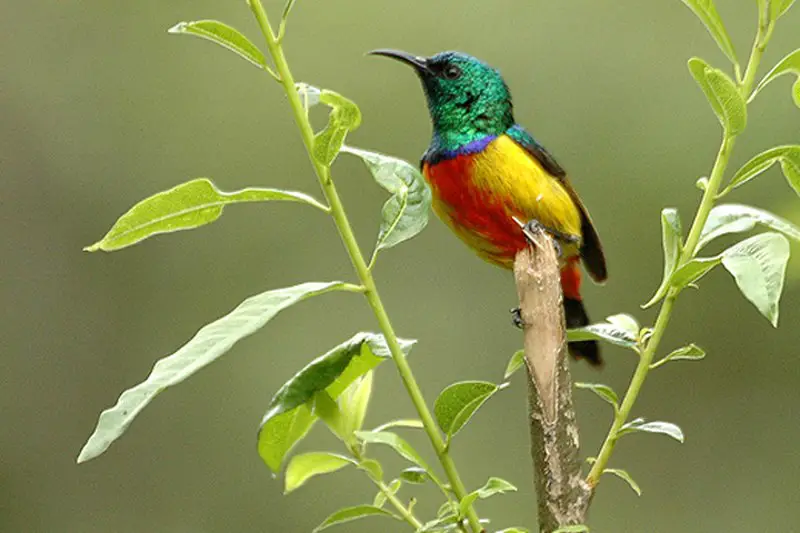
The Regal Sunbird is a small and elegant species of bird that can be found in the Albertine Rift montane forests.
The adult males have an iridescent golden-green coloured head, dark wings and tail, as well as a boldly marked red & yellow breast and belly.
Females are less colourful but still stunning with their dull olive upper parts, paired alongside faint streaks of yellow on the underside.
These sunbirds feed mainly off nectar from wild flowers which they get using their long curved bills; however they also eat insects for additional nutrients.
They tend to stay close to flowering shrubs or trees whilst singing beautiful songs throughout the day – making them one of nature’s most treasured creatures.Scientific classification:
| Kingdom | Animalia |
| Phylum | Chordata |
| Class | Aves |
| Order | Passeriformes |
| Family | Nectariniidae |
| Genus | Cinnyris |
| Species | C. regius |
39. Bucorvus
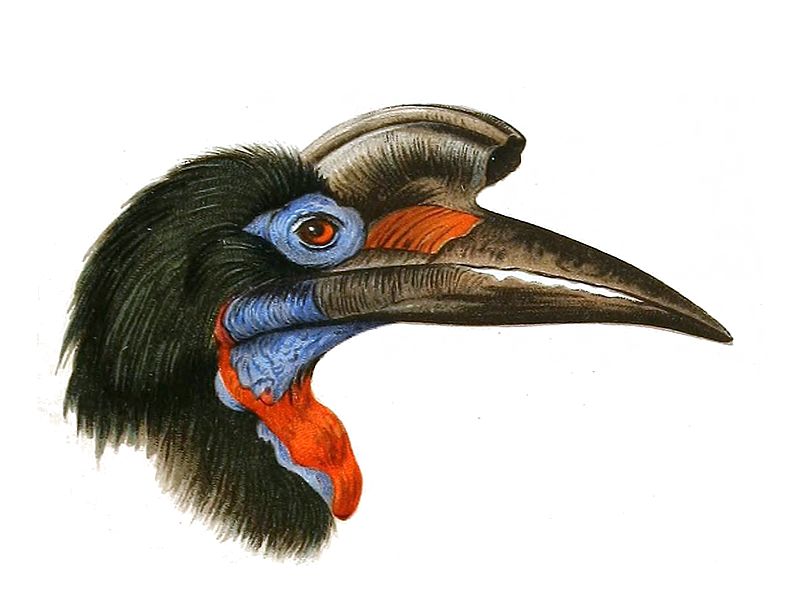
Bucorvus is a species of large bird from the family Bucorvidae, endemic to sub-Saharan Africa. They are approximately 1m tall and both species have black feathers with patches of red or purple on their wings and neck.
The Abyssinian ground hornbill occurs in a belt from Senegal east to Ethiopia while the southern ground hornbill lives in Southern and East Africa.
Ground Hornbills are omnivorous birds that feed mainly on insects, snakes, lizards, small mammals as well as fruits like figs.
They also build nests high up in trees which they line with mud for insulation before laying eggs inside them.
Their legs are very long allowing them to walk over distances looking for food sources easily compared to other avian speciesScientific classification:
| Kingdom | Animalia |
| Phylum | Chordata |
| Class | Aves |
| Order | Bucerotiformes |
| Family | Bucorvidae Bonaparte, 1854 |
| Genus | Bucorvus Lesson, 1830 |
Also Featured In: Endemic Ethiopian Birds You don’t Know,
40. New World Quail
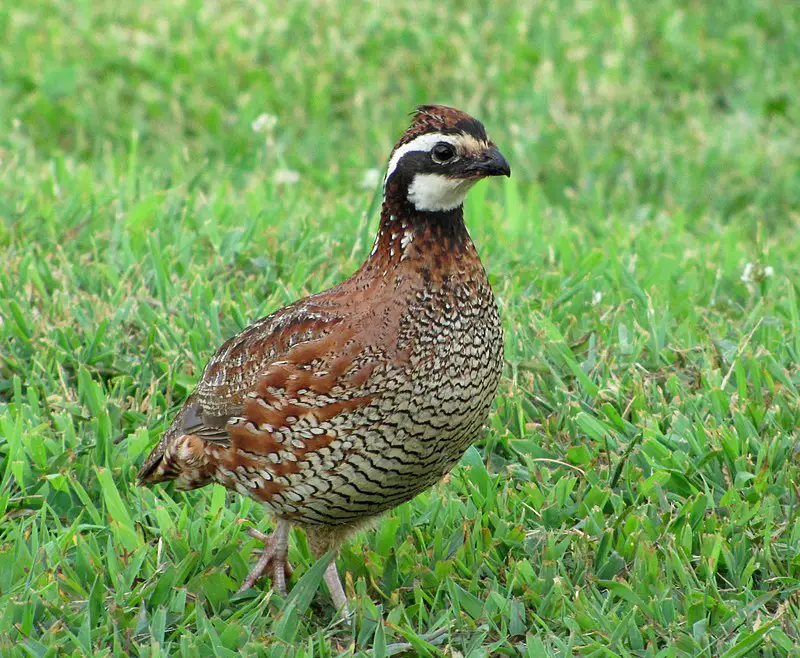
New World quail are small birds found in the Americas, from Canada to Brazil. They belong to their own family, Odontophoridae, and have similar appearance and habits as Old World quail which belong to a different family.
New World Quails come in various species such as California Quail and Bobwhite Quail.
These birds have adapted well to human presence due to availability of food resources like agricultural crops.
They also live close together where they form large flocks for safety against predators like foxes or hawks.
The males usually sport colorful feathers during mating season that helps them attract female mates while providing an amazing sight for us viewers.Scientific classification:
| Kingdom | Animalia |
| Phylum | Chordata |
| Class | Aves |
| Order | Galliformes |
| Superfamily | Phasianoidea |
| Family | Odontophoridae Gould, 1844 |
41. Slender-Billed Gull
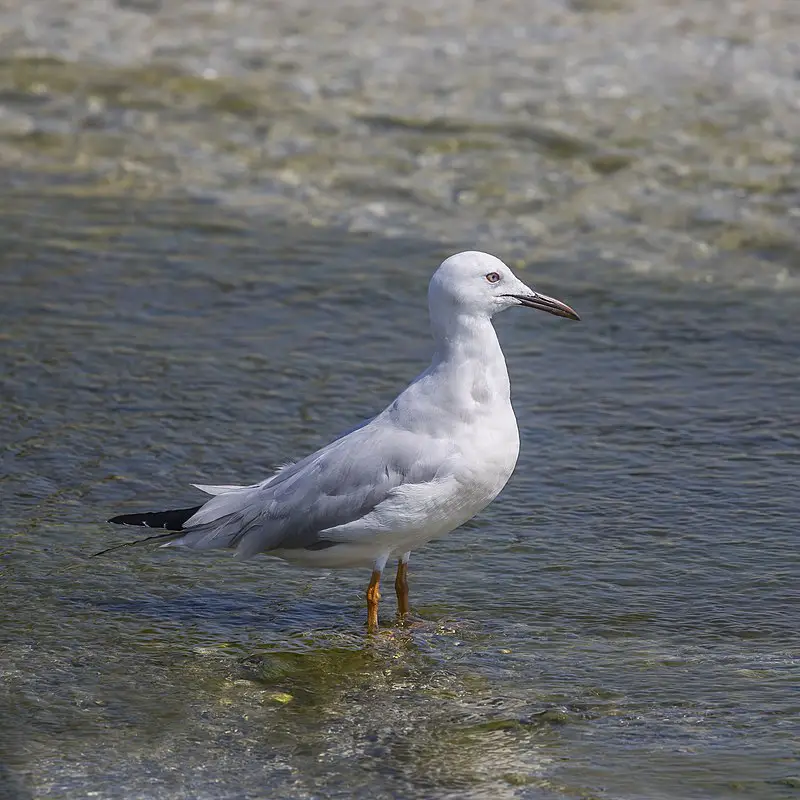
The Slender-billed Gull is a medium sized, migratory bird. It breeds in coastal lagoons and islands around the Mediterranean Sea and North Indian Ocean regions such as Pakistan.
During winter it travels further south to areas like Africa and India, but some individuals have been known to wander off towards western Europe too.
Its long slender bill gives this species its name; an unmistakable feature for identifying these birds among other gulls.
They are generally greyish-brown or white with black wingtips when seen from afar; although up close you can also make out their yellow legs and beak which contrasts nicely against its colouration.
Despite being classified as Least Concern by IUCN they still suffer threats of habitat destruction due to development projects that target their nesting sites along coastlines.Scientific classification:
| Kingdom | Animalia |
| Phylum | Chordata |
| Class | Aves |
| Order | Charadriiformes |
| Family | Laridae |
| Genus | Chroicocephalus |
| Species | C. genei |
Also Featured In: Ukrainian Birds You Should Know, Birds That Live in Iraq
42. Temminck’s Courser
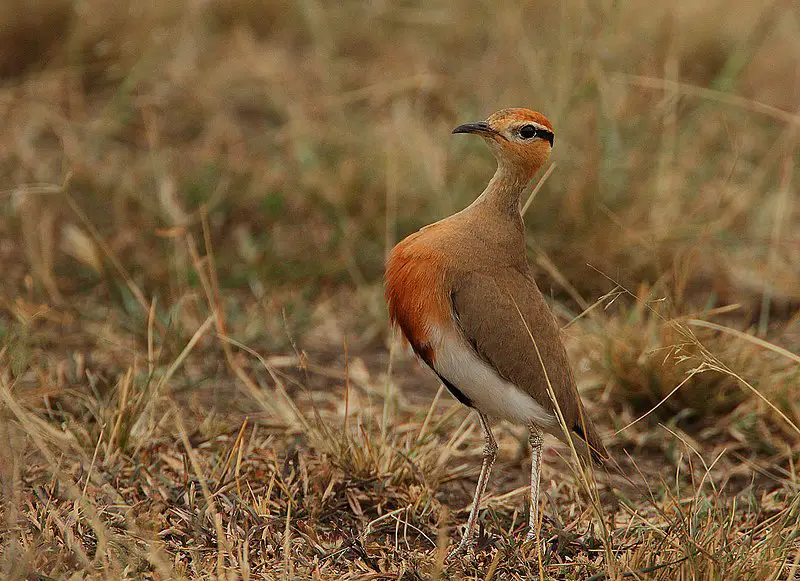
Temminck’s courser is a bird belonging to the pratincole and courser family, Glareolidae.
It is found in sub-Saharan Africa and prefers living in the African savannah where it lays its dark ash-black eggs amongst burnt bushes or grasses.
There are three known subspecies of this wader, which was named after Dutch naturalist Coenraad Jacob Temminck.
This species has greyish upperparts with white underparts while there may be some small black markings on the wings.
The bill and legs of these birds are yellowish brown while their eyes are large and bright red or orange in coloration.
They feed mainly on insects that they catch with short dashes across open ground before returning to cover again as soon as possible; also consuming other arthropods such as spiders when available.
Temminck’s Coursers usually occur singly but sometimes can be seen foraging together during winter months making them an interesting sight for any birder.Scientific classification:
| Kingdom | Animalia |
| Phylum | Chordata |
| Class | Aves |
| Order | Charadriiformes |
| Family | Glareolidae |
| Genus | Cursorius |
| Species | C. temminckii |
43. White-Spotted Flufftail
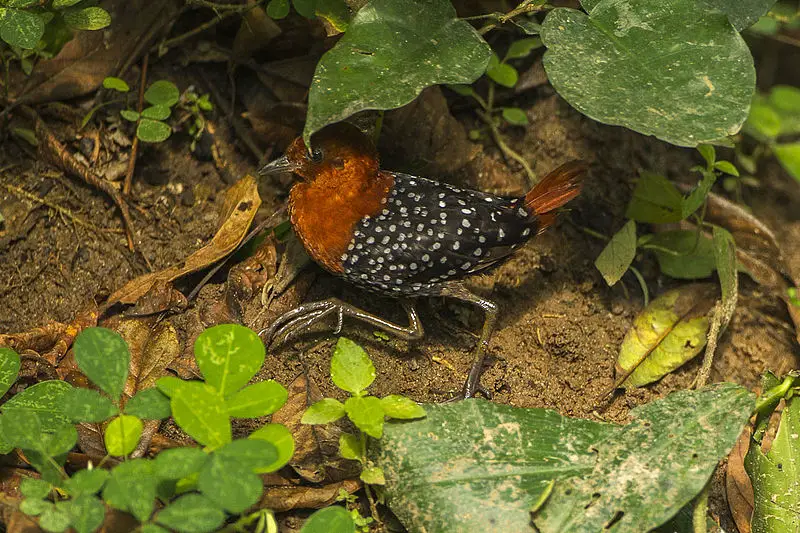
The white-spotted flufftail is a species of bird from the family Sarothruridae. It can be found in tropical rainforest regions across Africa, and its habitat consists of dense vegetation.
The colouration of this small bird is quite striking; it has a grey back, with reddish undertail coverts and black wings that are edged with white spots.
Its head features shades of brown and yellow, while its throat is notably creamy coloured.
These birds feed mainly on insects such as caterpillars but will also consume smaller amounts of fruit when available.
They build nests near water sources or under thick foliage to protect them from predators like hawks or crows which may attack their eggs or young chicks if they get too close by chance.
All in all, the white-spotted flufftail plays an important role in African ecology due to its insectivorous diet habits that help keep pest populations at bay.Scientific classification:
| Kingdom | Animalia |
| Phylum | Chordata |
| Class | Aves |
| Order | Gruiformes |
| Family | Sarothruridae |
| Genus | Sarothrura |
| Species | S. pulchra |
44. Southern Giant Petrel
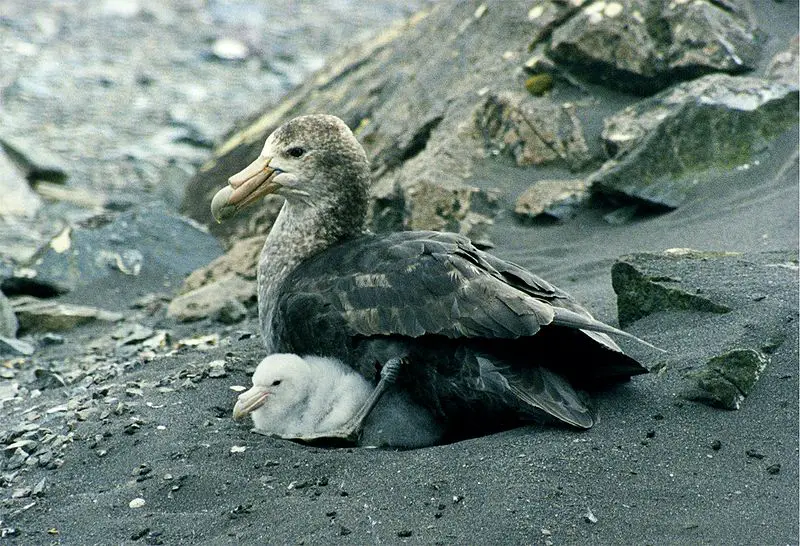
The Southern giant petrel is a large seabird native to the southern oceans, and it overlaps broadly with its similar counterpart, the Northern giant petrel.
Adults of both species can be distinguished by their bill-tip color: greenish in the south and yellowish in the north.
The Southern giant petrel also goes by other names such as Antarctic giant petrel, Giant fulmar, Stinker or Stinkpot.
These birds are around 75 cm (30 inches) long on average and have striking white plumage combined with brown wings that give them an impressive appearance while they soar through skies above open waters searching for food like fish, krill and squid – which they can catch up to 100 meters below sea level.Scientific classification:
| Kingdom | Animalia |
| Phylum | Chordata |
| Class | Aves |
| Order | Procellariiformes |
| Family | Procellariidae |
| Genus | Macronectes |
| Species | M. giganteus |
Also Featured In: Birds that Live in the Ocean , Birds that Live around Victoria
45. Crested Guineafowl
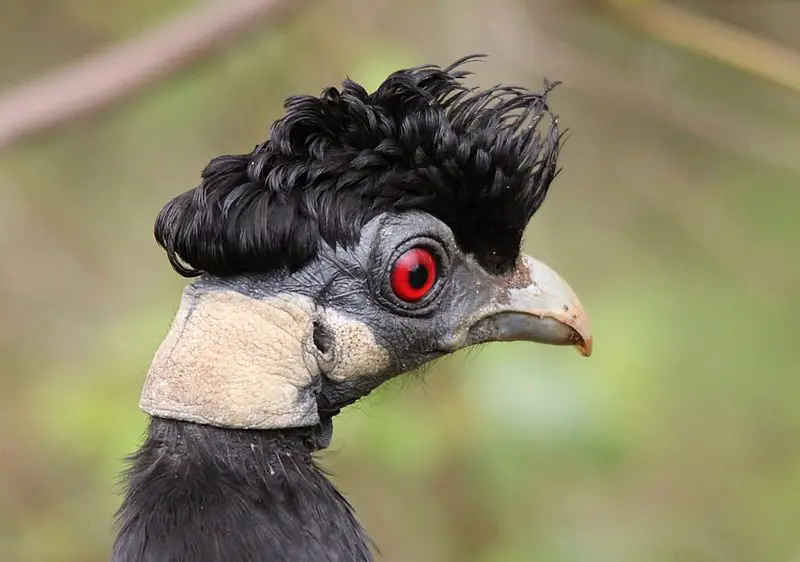
The Crested Guineafowl is a beautiful bird native to sub-Saharan Africa. It has an overall blackish plumage with dense white spots, and features a distinctive black crest on the top of its head.
This guineafowl species typically measures around 50 cm in length and weighs between 721 – 1,543 g.
Its habitats include open forest, woodland and forest-savanna mosaics where it can find plenty of insects to feed on as well as some seeds or fruits from time to time.
As their populations are considered stable at the moment there is no need for conservation efforts but they should be monitored closely due to potential threats such as habitat loss caused by human activities like deforestation or poaching for meat consumption or egg collecting purposes.Scientific classification:
| Kingdom | Animalia |
| Phylum | Chordata |
| Class | Aves |
| Order | Galliformes |
| Family | Numididae |
| Genus | Guttera |
| Species | G. pucherani |
46. Barn-Owls
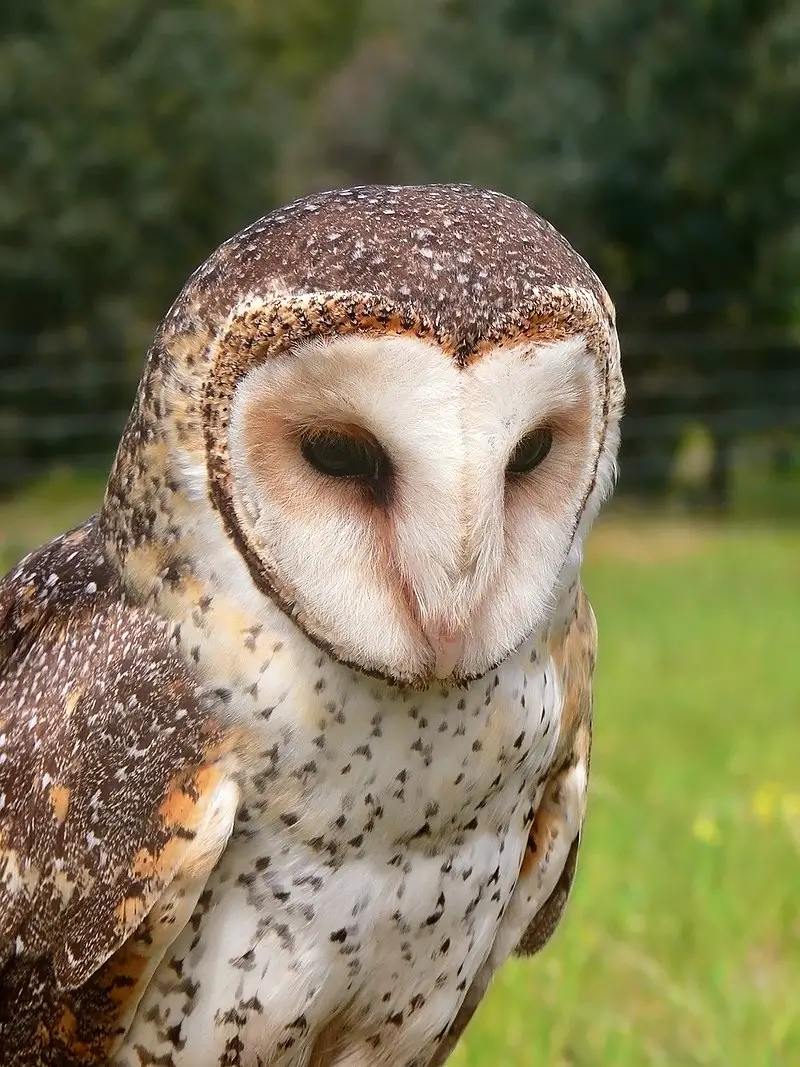
Barn-owls belong to the family Tytonidae and are distinguishable from other owls by their large heads, heart-shaped faces and long legs with powerful talons.
They inhabit a wide range of habitats, including grasslands, deserts, forests and wetlands.
These nocturnal birds hunt mainly small mammals like voles but also consume insects such as beetles or moths when available.
Barn-owls have excellent vision at night which helps them locate prey in even the darkest of conditions.
Their unique call is often heard during dusk or dawn which has earned them nicknames such as “screech owl” or “ghost owl”.
As they help control rodent populations they can be beneficial for farmers who may find barn-owls nesting on their property.Scientific classification:
| Kingdom | Animalia |
| Phylum | Chordata |
| Class | Aves |
| Order | Strigiformes |
| Family | Tytonidae Ridgway, 1914 |
Also Featured In: Lebanon Birds Live in Semi-Desert Areas, Birds You’ll Find in Moldova
47. Eastern Plantain-Eater
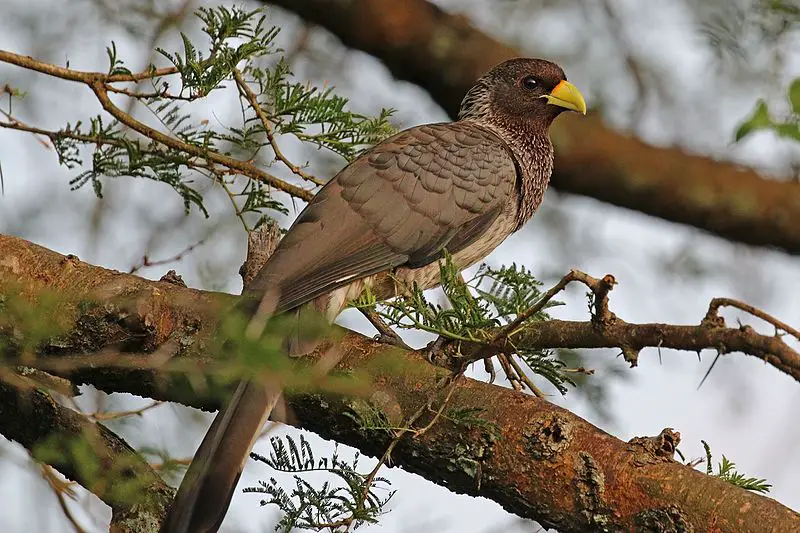
The Eastern Plantain-eater is a large member of the Turaco family, found in open woodland habitats throughout tropical east Africa.
They are common and noisy birds, making them easy to spot due their bright plumage and lively behaviour.
With long wings and tail feathers they have impressive flying abilities which can be seen when moving from tree to tree.
Nesting high up on trees these birds build platform nests made out of twigs for laying two or three eggs at a time.
The diet mainly consists of fruit such as plantains but also includes insects during breeding season when young need protein rich food sources for healthy development into adulthood.Scientific classification:
| Kingdom | Animalia |
| Phylum | Chordata |
| Class | Aves |
| Order | Musophagiformes |
| Family | Musophagidae |
| Genus | Crinifer |
| Species | C. zonurus |
48. Blue-Headed Coucal
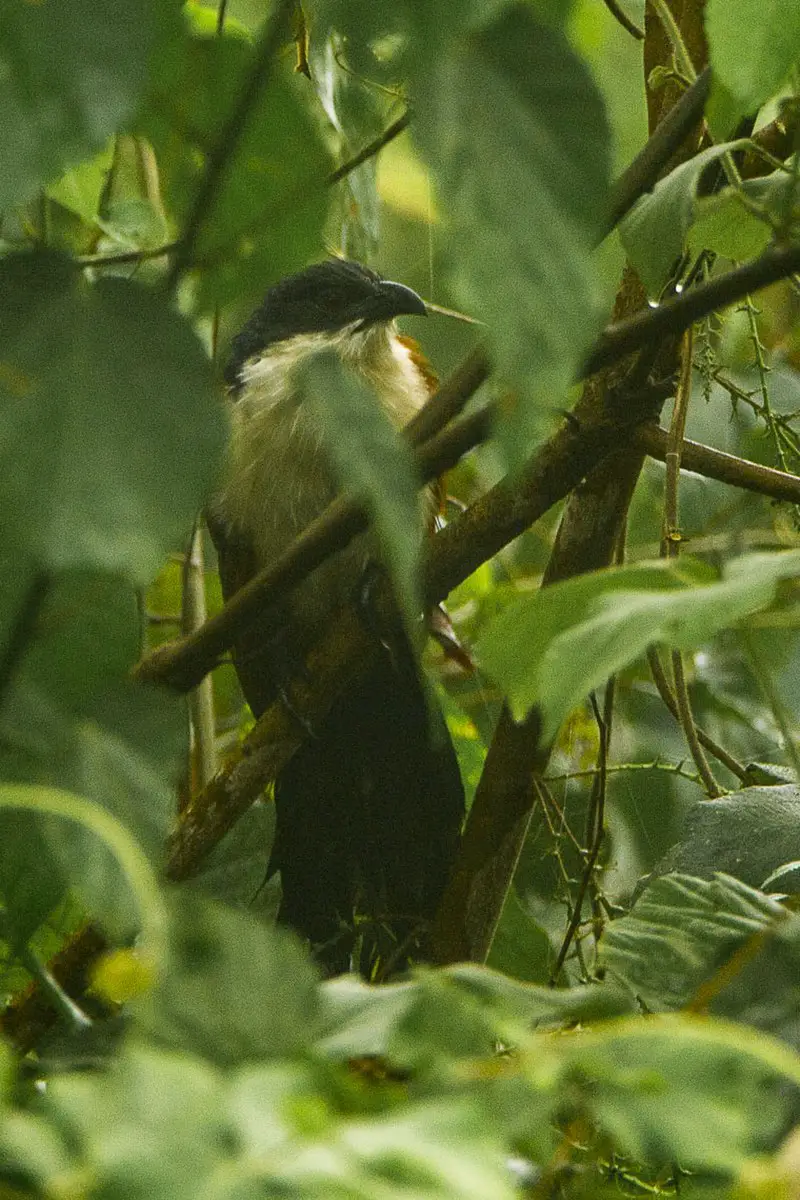
The Blue-headed coucal is a beautiful and unique species of cuckoo found in tropical central Africa. It inhabits areas near swamps, rivers, forests edges and other wet environments.
This bird is quite common with a large range which has led the IUCN to rate its conservation status as “least concern”.
Its distinguishing feature are its striking blue head feathers that it uses for courtship displays when searching for mates during breeding season.
The diet consists mainly of insects but can also include small reptiles or amphibians if available.
Despite their wide range they remain vulnerable due to changes in land use such as deforestation or agricultural development so careful monitoring must continue to ensure the survival of this charming species.Scientific classification:
| Kingdom | Animalia |
| Phylum | Chordata |
| Class | Aves |
| Order | Cuculiformes |
| Family | Cuculidae |
| Genus | Centropus |
| Species | C. monachus |
49. Yellow-Billed Stork
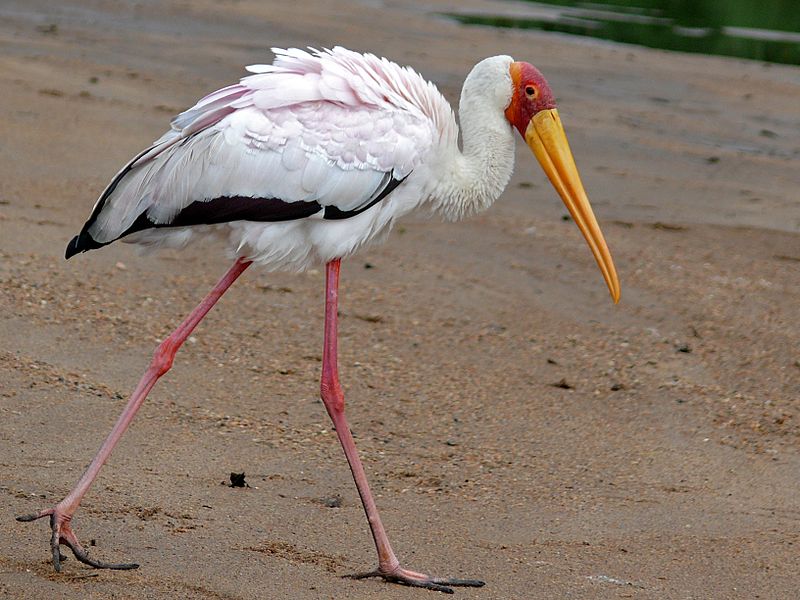
The yellow-billed stork is a large wading bird found in Africa south of the Sahara as well as Madagascar.
It belongs to the family Ciconiidae and has three other species in its genus – Mycteria americana, Mycteria cinerea and Leptoptilos javanicus.
This majestic bird stands at an average height of up to 1 meter with a wingspan that can reach 2 meters wide.
Its plumage is predominantly white with black flight feathers that contrast against its bright yellow bill for which it is named after.
The Yellow-billed Stork feeds on fish, frogs, insects and small reptiles like snakes by probing deep into mud or shallow water bodies using its long beak.
These captivating birds are also known to form colonies during their nesting season from August until October where they build nests out of sticks atop tall trees near wetlands or riversides.Scientific classification:
| Kingdom | Animalia |
| Phylum | Chordata |
| Class | Aves |
| Order | Ciconiiformes |
| Family | Ciconiidae |
| Genus | Mycteria |
| Species | M. ibis |